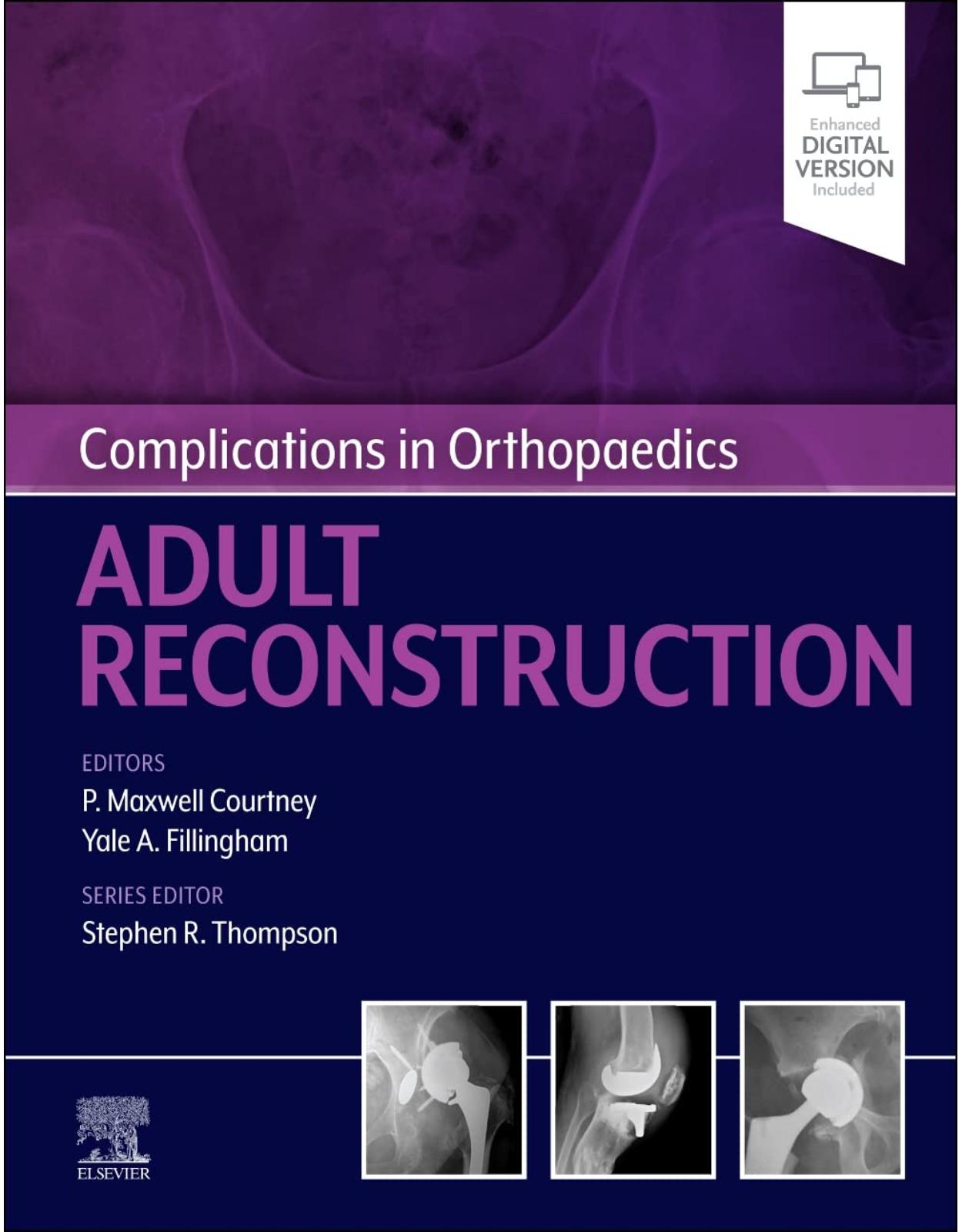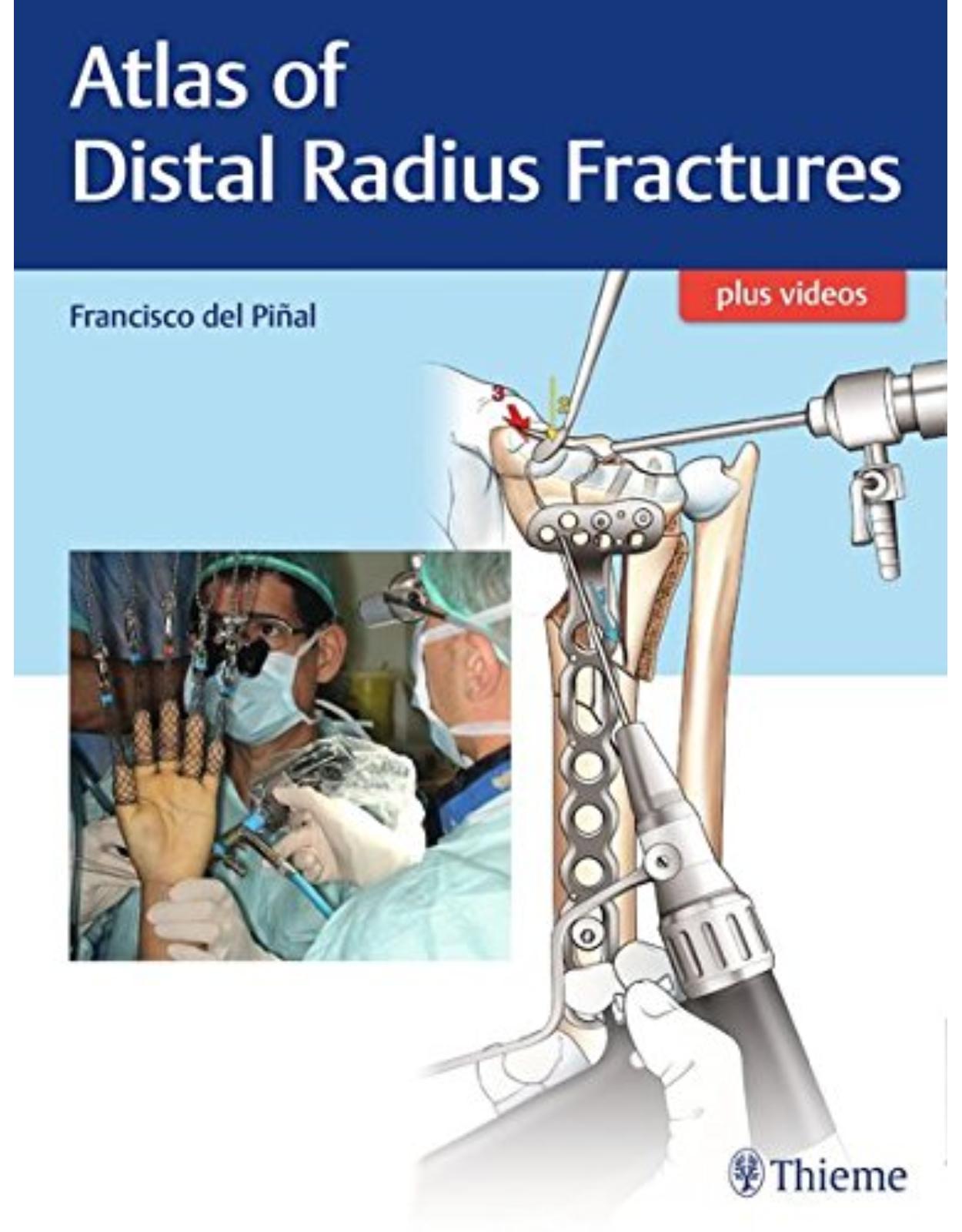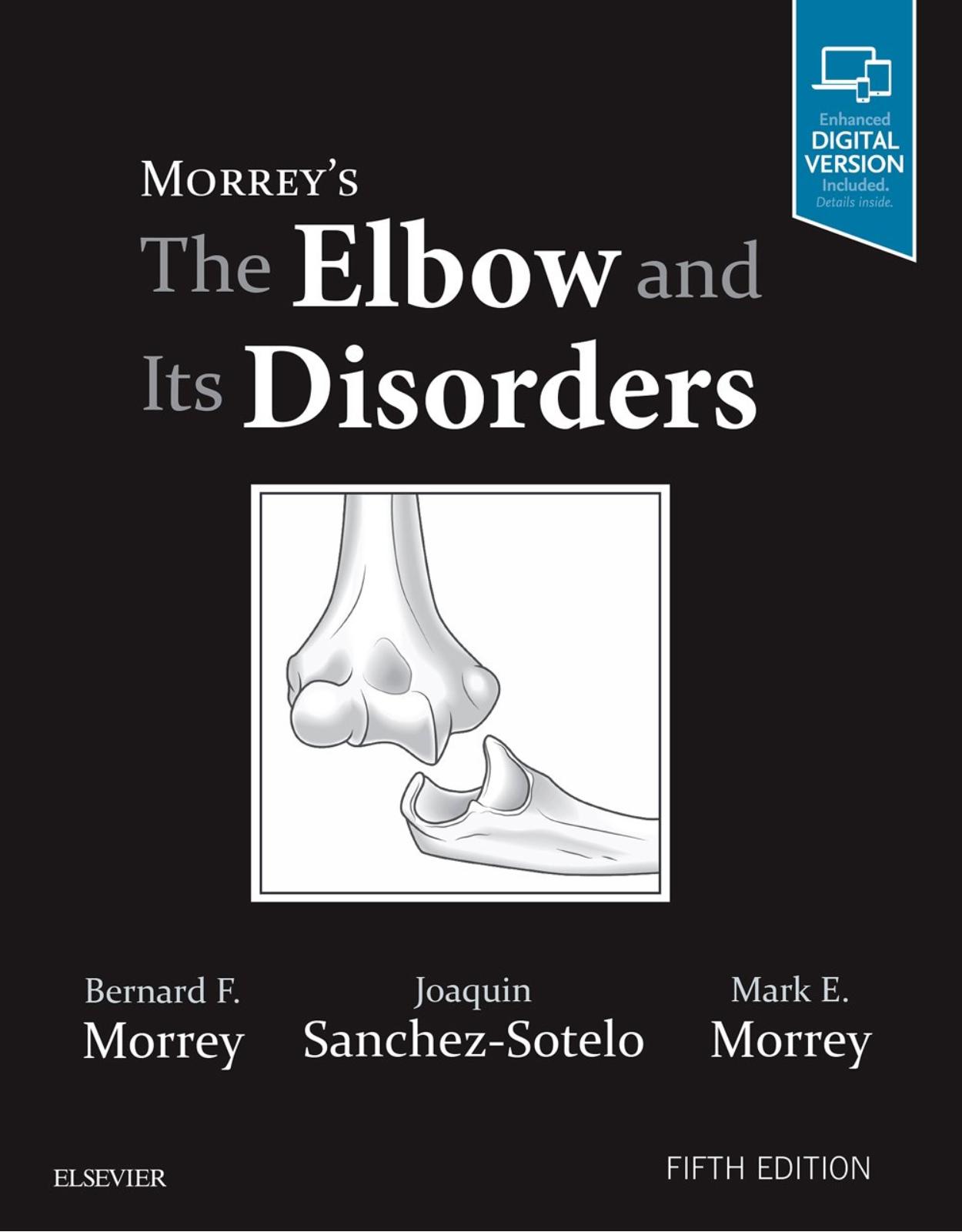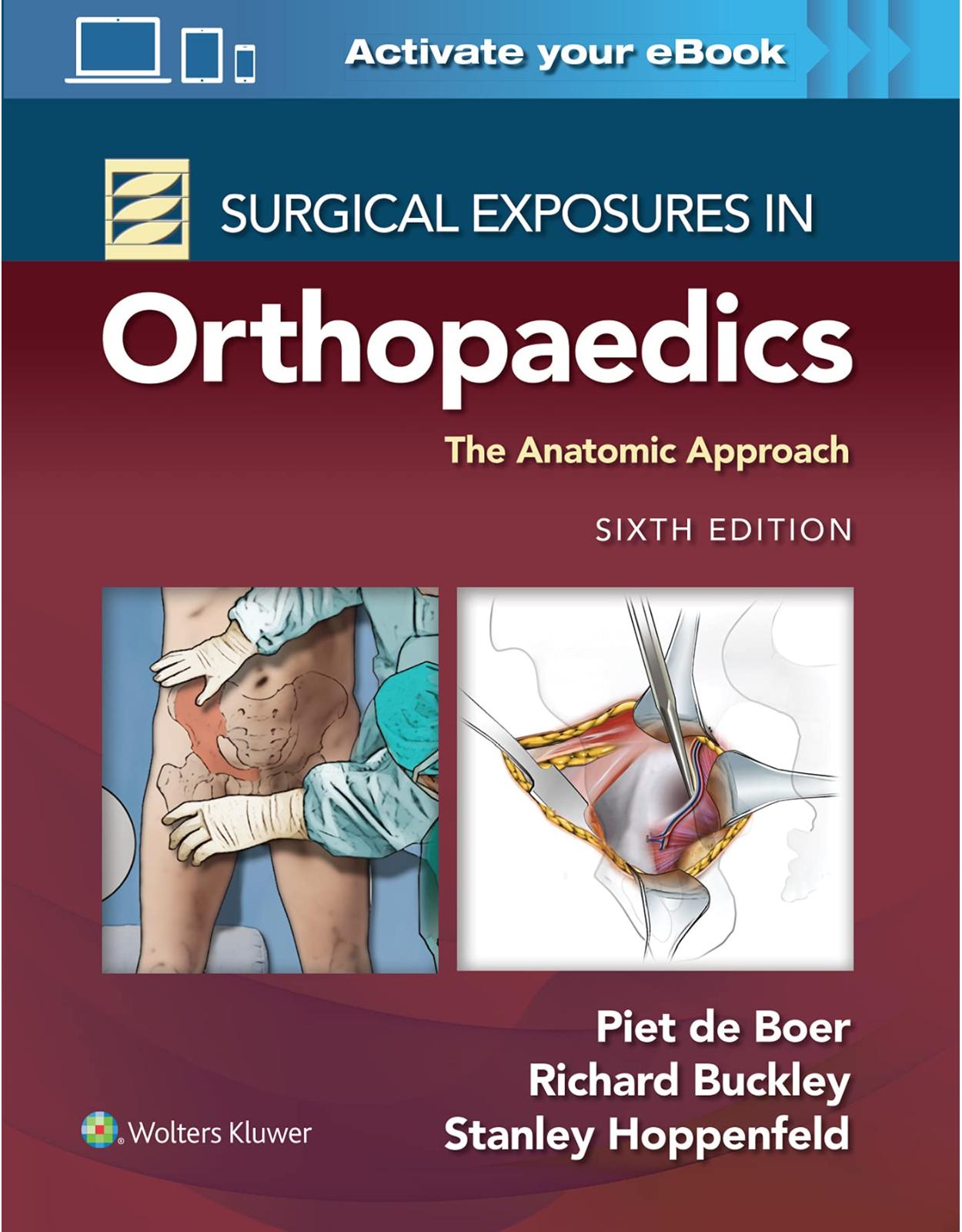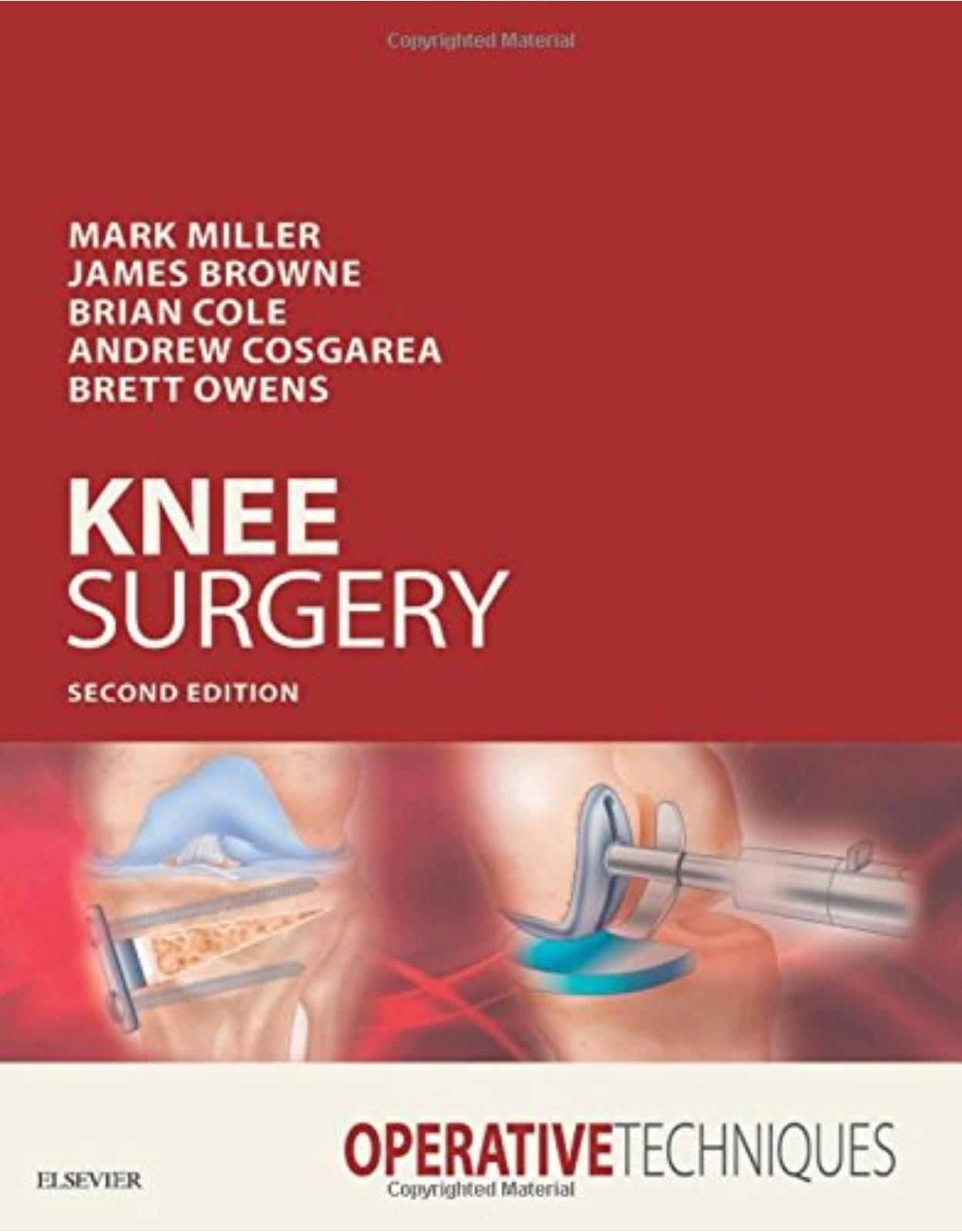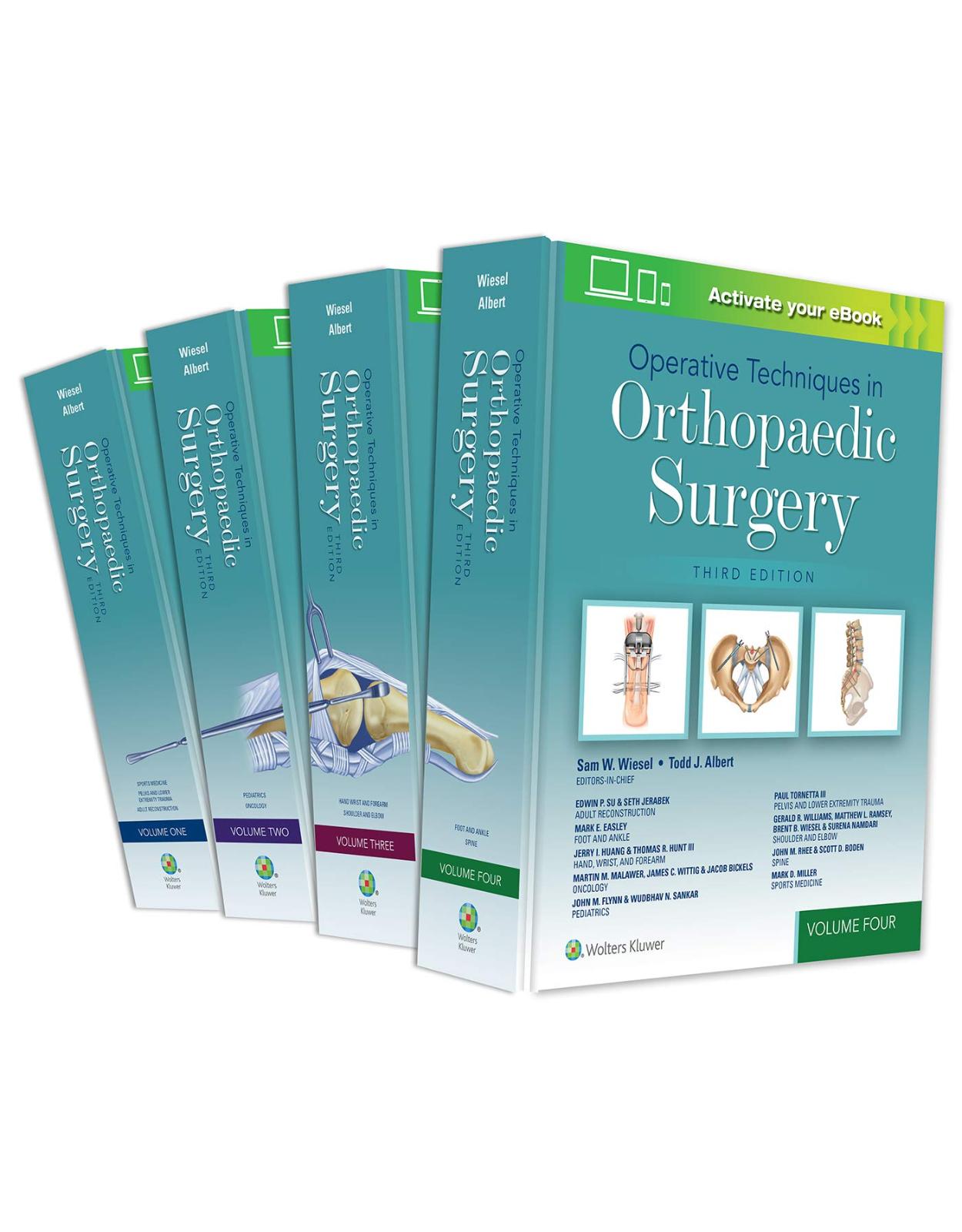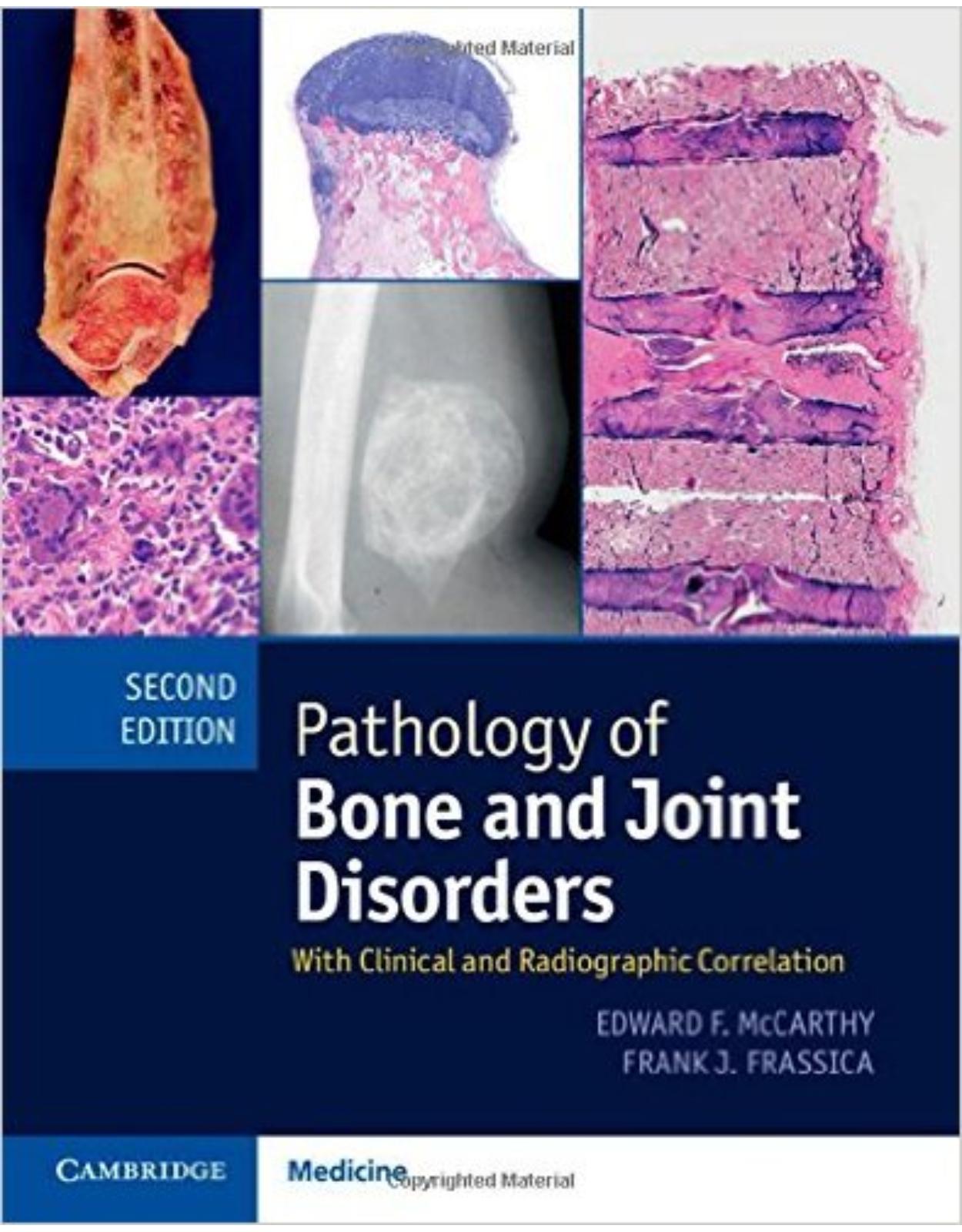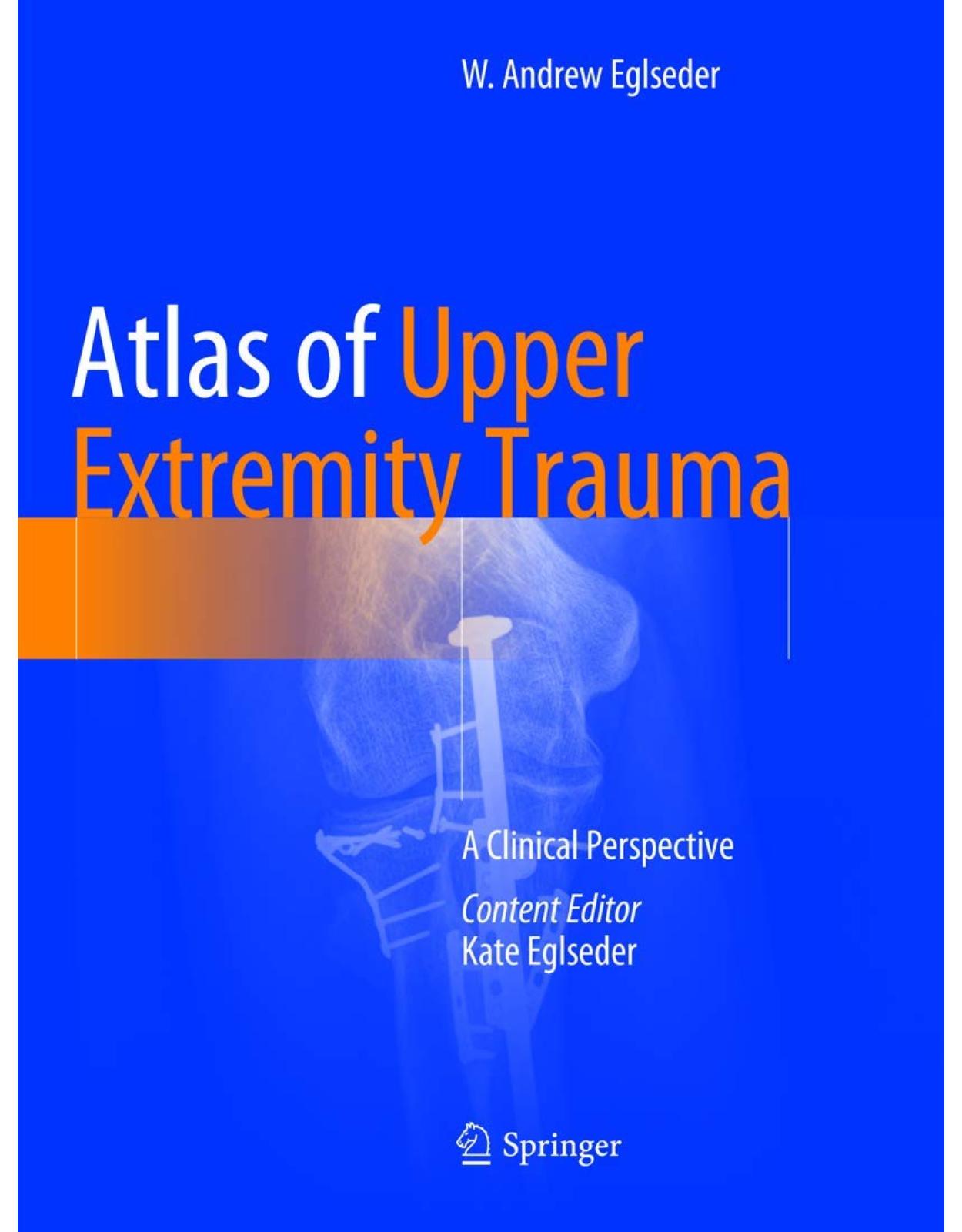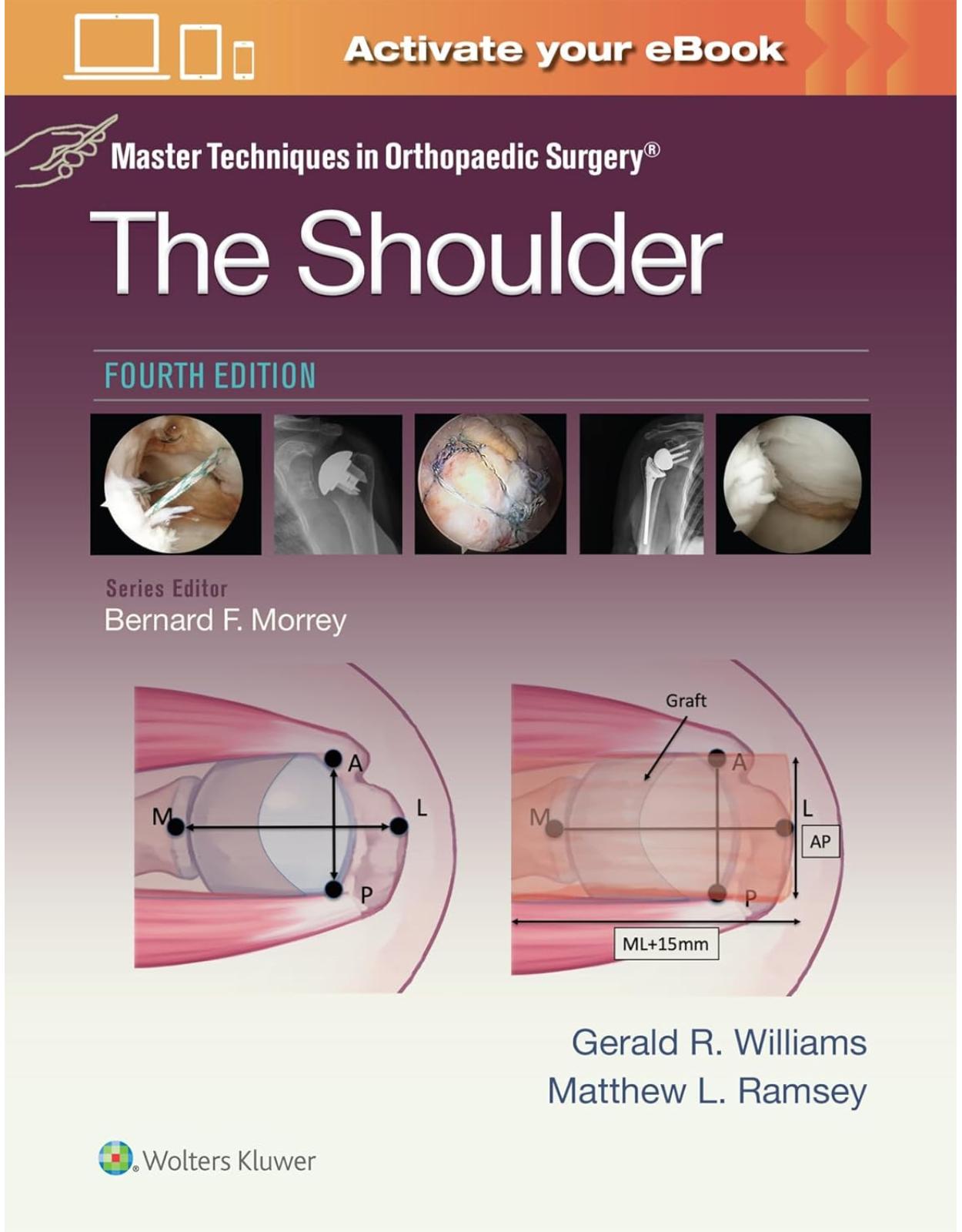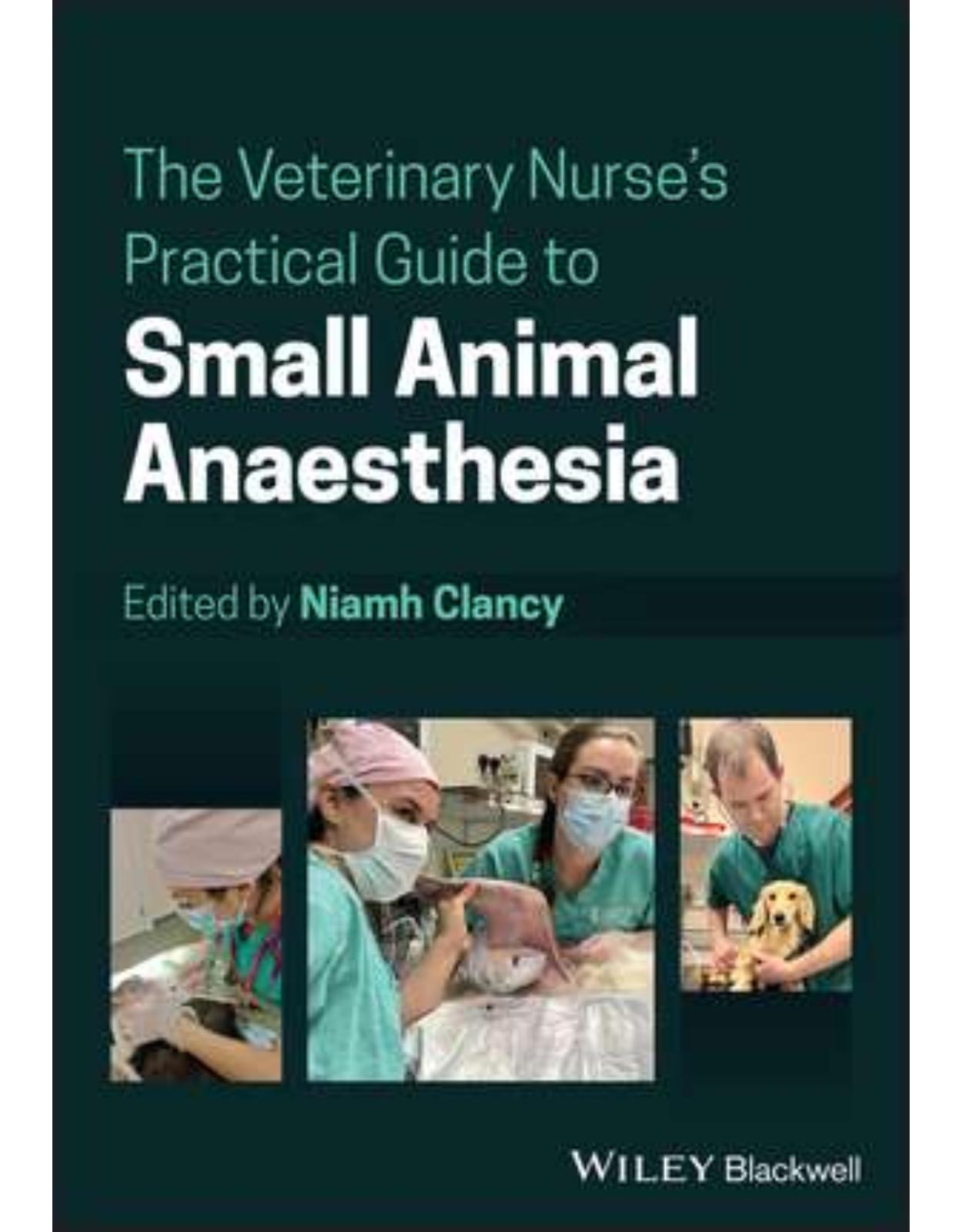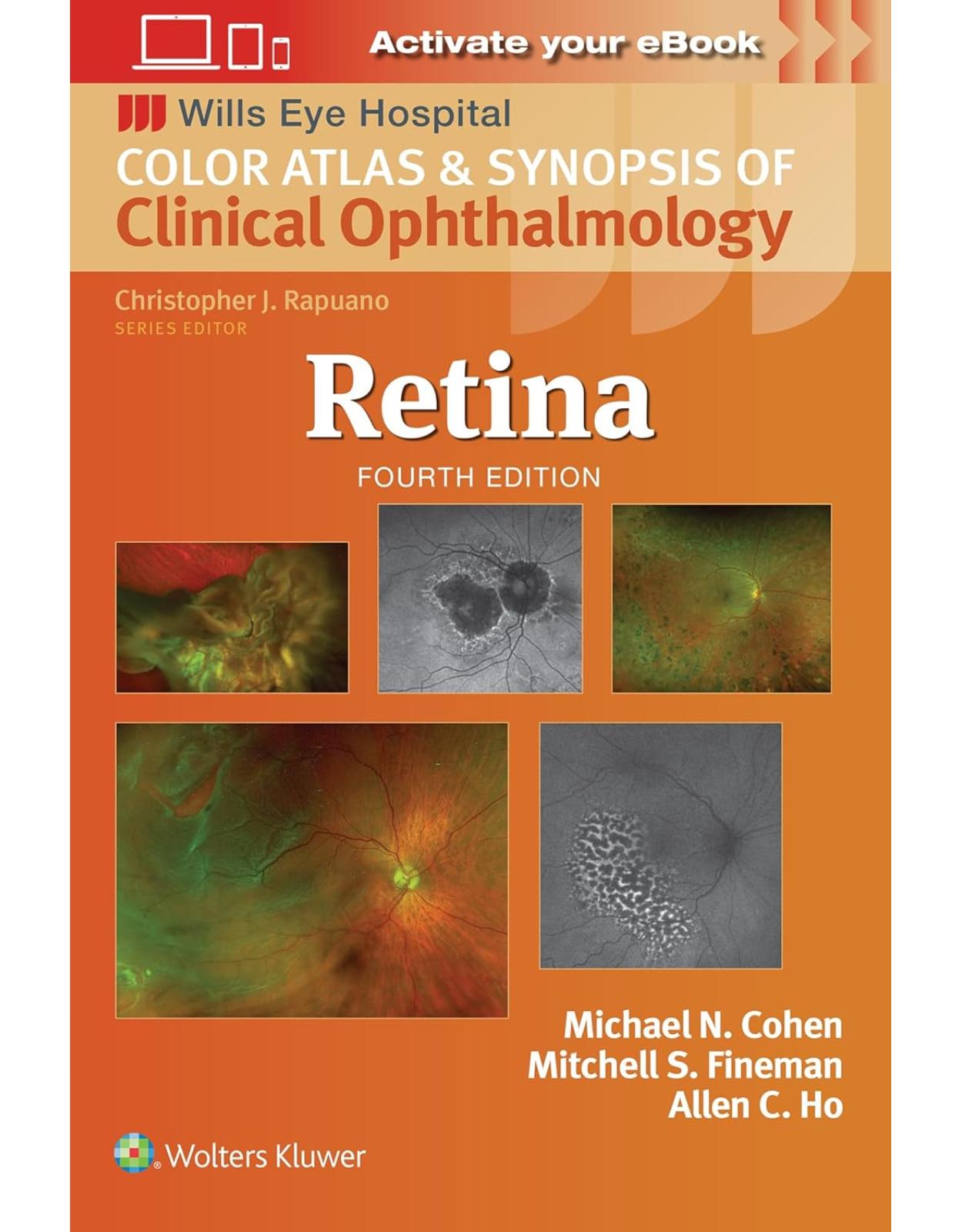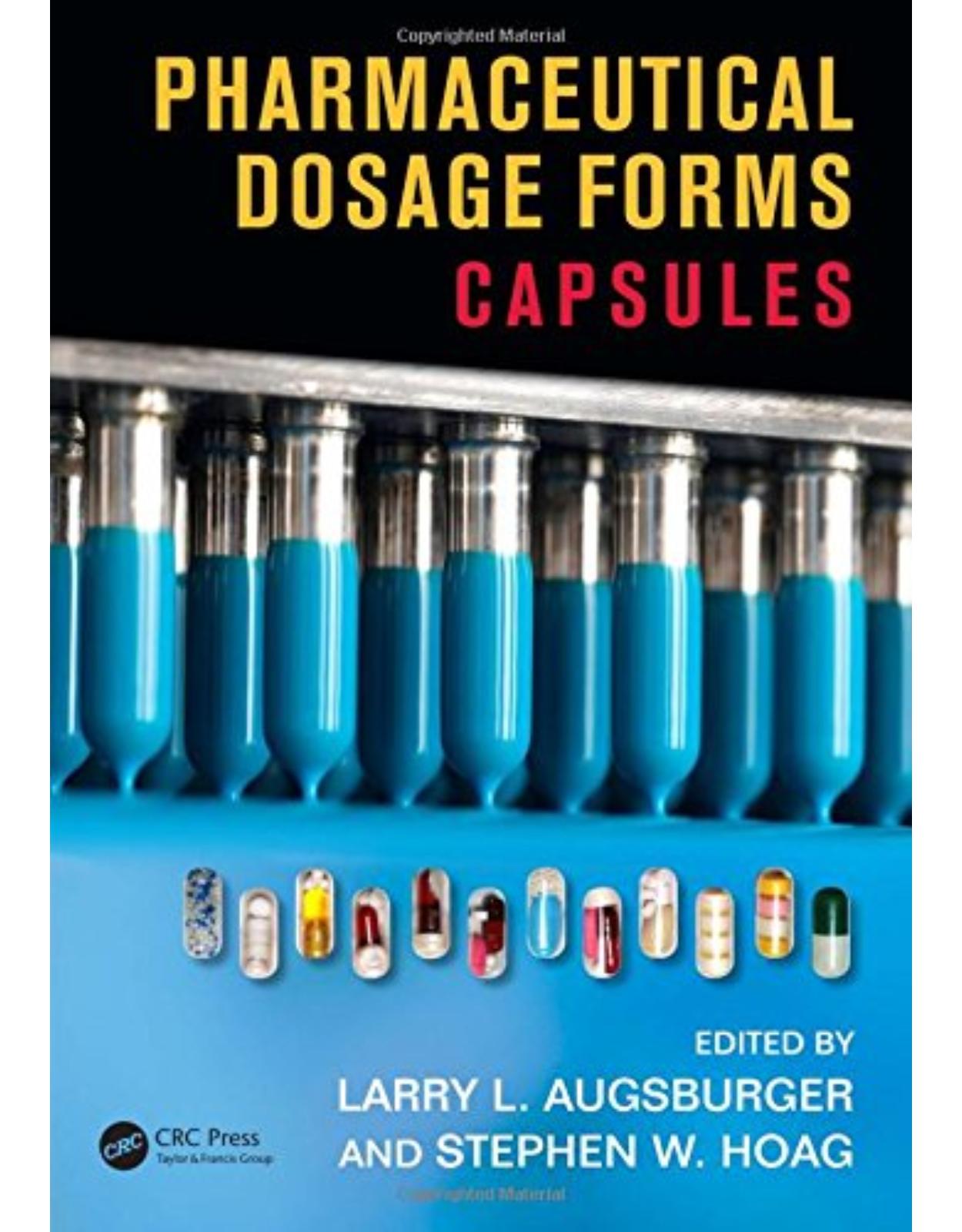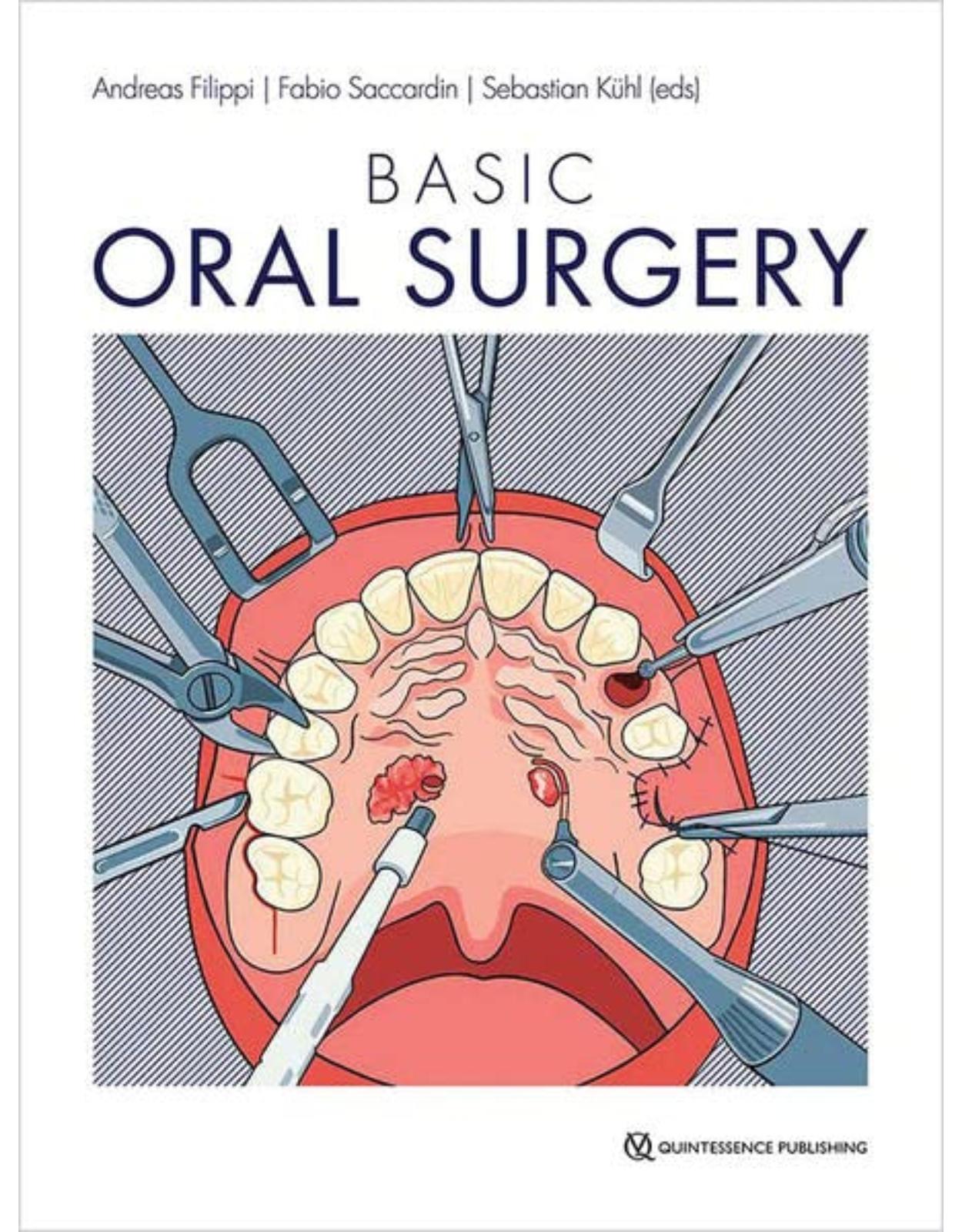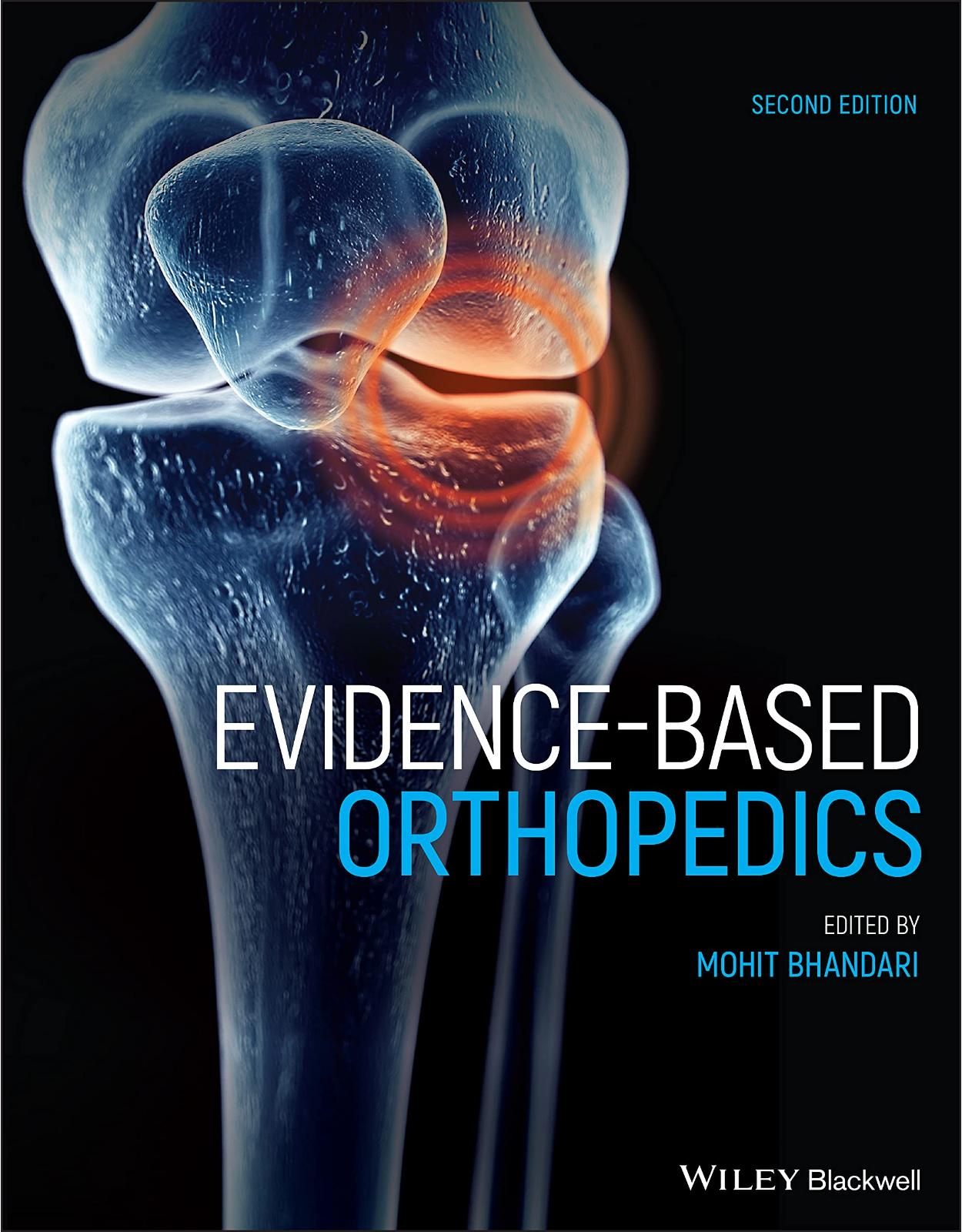
Evidence-Based Orthopedics, 2nd Edition
Livrare gratis la comenzi peste 500 RON. Pentru celelalte comenzi livrarea este 20 RON.
Disponibilitate: La comanda in aproximativ 4 saptamani
Autor: Mohit Bhandari
Editura: Wiley
Limba: Engleza
Nr. pagini: 1184
Coperta: Hardcover
Dimensiuni: 22.86 x 4.83 x 27.94 cm
An aparitie: 9 Sept. 2021
Description:
Evidence-Based Orthopedics is an up-to-date review of the best evidence for the diagnosis, management, and treatment of orthopedic conditions. Covering orthopedic surgery as well as pre- and post-operative complications, this comprehensive guide provides recommendations for implementing evidence-based practice in the clinical setting. Chapters written by leading clinicians and researchers in the field are supported by tables of evidence that summarize systematic reviews and randomized controlled trials. In areas where evidence is insufficient to recommend a practice, summaries of the available research are provided to assist in decision-making.
This fully revised new edition reflects the most recent evidence using the approved evidence-based medicine (EBM) guidelines and methodology. The text now places greater emphasis on GRADE--a transparent framework for developing and presenting summaries of evidence--to allow readers to easily evaluate the quality of evidence and the strength of recommendations. The second edition offers a streamlined presentation and an improved standardized format emphasizing how evidence in each chapter directly affects clinical decisions. Incorporating a vast amount of new evidence, Evidence-Based Orthopedics:
Features thoroughly revised and updated content, including a new chapter on pediatric orthopedics and new X-ray images
Provides the evidence base for orthopedic surgery as well as pediatric orthopedics and orthopedic conditions requiring medical treatment
Covers the different methods for most orthopedic surgical procedures, such as hip replacements, arthroscopy, and knee replacements
Helps surgeons and orthopedic specialists achieve a uniform optimum standard through a condition-based approach
Aligns with internationally accepted guidelines and best health economic principles Evidence-Based Orthopedics is an invaluable resource for orthopedic specialists, surgeons, trauma surgeons, trainees, and medical students.
Table of Contents:
I: Methodology of Evidence‐Based Orthopedics
1 Principles of Evidence‐Based Orthopedics
Introduction
Importance of evidence‐based orthopedics
Top four questions
Question 1: What are the most important principles of evidence‐based orthopedics?
Question 2: How do you apply evidence‐based orthopedics?
Question 3: What is an example of applying evidence‐based orthopedics?
Question 4: What are the misconceptions of evidence‐based orthopedics?
Summary of answers
References
2 Hierarchy of Evidence and Common Study Designs
Introduction
Top five questions
Question 1: What is the hierarchy of evidence for therapy studies?
Question 2: What are randomized controlled trials (RCTs)?
Question 3: What are observational studies?
Question 4: What are case series and case reports?
Question 5: What are systematic reviews and where do they fit in the hierarchy of evidence?
Summary
References
3 Systematic Reviews and Meta‐Analyses
Introduction
Top four questions
Question 1: What are the types of literature reviews?
Question 2: How is a systematic review performed?
Question 3: How is a meta‐analysis performed?
Question 4: How does one critically appraise a systematic review and meta‐analysis?
Summary of answers
References
4 Healthcare Recommendations: Grades of Recommendation, Assessment, Development, and Evaluation (GRADE) Approach
Case scenario
Top three questions
Question 1: What is GRADE?
Question 2: What are the components of a GRADE quality of evidence assessment, and how do you evaluate them for a body of evidence?
Question 3: How do you use your GRADE quality of evidence assessment to develop a clinical recommendation?
Summary of answers
Additional resources
References
5 Outcomes and Their Interpretations
Introduction
Top three questions
Question 1: What is an outcome measure?
Question 2: What properties of outcome measures do I have to know?
Question 3: How should I choose an outcome measure?
Biophysical/clinical outcome measures
Patient‐reported outcome measures (PROMs)
Objective physical function outcome measures
Summary of answers
References
6 Value‐Based Orthopedics
Introduction
Top four questions
Question 1: What is value‐based healthcare?
Question 2: How can value be improved?
Question 3: How can value‐based healthcare be applied to orthopedics?
Question 4: What are the practical challenges with value‐based orthopedics?
Summary of answers
References
Further reading
II: Orthopedic Medicine
7 Critical Issues in Osteoporosis Management
Clinical scenario
Importance of the problem
Top three questions
Question 1: In postmenopausal women aged >50 who have sustained fragility fractures, how does the diagnosis of osteoporosis determine the risk for future fracture?
Question 2: In postmenopausal women with low BMD or prior fragility fractures, which pharmacological therapies, compared to no medications, best reduce the risk for future fractures?
Question 3: In patients with low BMD or who have sustained a fragility fracture, what is the appropriate duration of pharmacotherapy to avoid adverse side effects?
Summary of answers
References
8 Venous Thromboembolic Events
Clinical scenario
Top three questions
Question 1: In patients undergoing major orthopedic surgery, does one modality, compared to others, most effectively reduce thromboembolic event rates?
Question 2: In patients undergoing major orthopedic surgery, does preoperative initiation of thromboprophylaxis, compared to peri‐ or postoperative initiation, reduce thromboembolic event rates?
Available literature and quality of the evidence
Question 3: In patients with isolated lower‐limb injuries who require immobilization, does thromboprophylaxis, compared to no prophylaxis, reduce thromboembolic event rates?
Summary of answers
References
9 Blood Transfusion
Clinical scenario
Top three questions
Question 1: Amongst patients undergoing orthopedic surgery, how common are perioperative blood transfusions compared to patients undergoing other types of surgery?
Question 2: In patients undergoing orthopedic surgery, are perioperative blood management strategies effective at reducing transfusion rates compared to usual care?
Question 3: In postoperative orthopedic surgery patients, what transfusion threshold results in optimal outcomes compared to usual care?
Summary of answers
References
10 Wound Infections
Clinical scenario
Question 1: In patients undergoing orthopedic surgery, does routine antibiotic prophylaxis, compared to antibiotic administration, prevent surgical site infections?
Question 2: In patients with a suspected surgical site infection, what is the optimal workup leading to accurate diagnosis and treatment?
Question 3: In patients with a surgical site infection and infected hardware, does hardware retention, compared to removal of hardware, result in improved outcomes?
Summary of answers
References
11 Smoking Cessation
Clinical scenario
Introduction
Top three questions
Question 1: In patients undergoing orthopedic procedures, do smokers, compared to nonsmokers, have worse outcomes?
Question 2: In patients undergoing orthopedic procedures, does smoking cessation, compared to persistent smoking, decrease the likelihood of a poor outcome?
Question 3: In orthopedic patients, are certain modalities, compared to others, more effective at initiating smoking cessation in orthopedic patients?
Summary of answers
References
12 Perioperative Medical Management
Top three questions
Question 1: In patients presenting with a fragility hip fracture, does routine preoperative echocardiography, compared to no echocardiography, improve survival?
Question 2: In fragility fracture patients, does orthopedic and medical co‐management, compared to usual care, improve outcomes such as length of stay, mortality, and readmission?
Question 3: In fragility fracture patients undergoing surgery, does early surgery, when compared to delayed surgery, have an effect on mortality risk?
Summary of answers
References
13 Orthobiologics
Clinical scenario 1
Clinical scenario 2
Top three questions
Question 1: In patients with open tibial shaft fractures, does the addition of bone‐morphogenetic protein (BMP) at the fracture site during intramedullary nailing reduce the risk of nonunion compared to intramedullary nailing alone?
Question 2: In patients with long‐bone nonunions, does the use of BMP during revision surgery improve the rate of union compared to revision surgery alone?
Question 3: In patients undergoing primary spinal fusion, does the use of BMP improve the rate of union compared to the use of iliac crest bone graft?
Summary of answers
References
14 Intimate Partner Violence
Clinical scenario
Top three questions
Question 1: In adult women with orthopedic injuries who present to fracture clinics, what is the prevalence of intimate partner violence (IPV), and how does this compare to the general population?
Question 2: Do specific educational programs, compared to traditional education, for healthcare professionals improve universal IPV identification and referral to assistance programs?
Question 3: In adult women who present to fracture clinics, are universal IPV identification and assistance interventions, compared to standard practice, effective at improving health outcomes for women?
References
15 Pain Management in Orthopedic Surgery
Clinical scenario 1
Clinical scenario 2
Top three questions
Question 1: In adult patients undergoing surgery, which acute perioperative pain management strategies, compared to others, are most effective at managing perioperative pain?
Systemic analgesia
Regional analgesia
Nonpharmacological options
Question 2: In adult patients undergoing surgery, which opioid‐sparing strategies, compared to standard care, are most effective?
Question 3: In adult patients undergoing surgery, what is the burden of persistent postoperative pain, and are there any interventions which, compared to usual care, can prevent persistent postsurgical pain?
Summary of answers
References
16 Post‐Traumatic Stress Disorder and Depression
Clinical scenario
Top three questions
Question 1: What are post‐traumatic stress disorder and depression, and does their presence, in orthopedic patients, have an impact on postoperative outcomes?
Question 2: How prevalent is PTSD and depression after acute trauma in the orthopedic trauma population?
Question 3: In orthopedic trauma patients with PTSD and/or depression, are there resources that, compared to usual care, improve outcomes?
Summary of answers
References
17 Nutrition and Supplements in Orthopedic Care
Clinical scenario
Top three questions
Question 1: In orthopedic surgery patients, do vitamin D and calcium supplementation, compared to no supplementation, confer a benefit in terms of fracture risk, fracture healing, or bone mineral density?
Question 2: Among patients undergoing orthopedic surgery, do those with a high BMI have a higher risk of complications compared to those with a normal BMI?
Question 3: Among patients undergoing orthopedic surgery, do those with undernutrition or malnutrition have poorer outcomes compared to those with adequate nutrition?
Summary of answers
References
III: Joint Reconstruction
18 Outpatient Total Joint Arthroplasty
Clinical scenario
Top three questions
Question 1: In eligible patients undergoing TJA, does performing the procedure and discharging the patient on the same day of the operation result in an additional risk of serious adverse events or readmissions compared to the same procedures performed on an inpatient basis?
Question 2: In eligible patients undergoing TJA, does performing the procedure on an outpatient basis result in cost savings compared to the same procedures performed on an inpatient basis?
Question 3: In patients undergoing an outpatient TJA, what factors are necessary to ensure a successful procedure compared to the general population undergoing TJA?
Summary of answers
References
19 Hip Preservation
Introduction
Clinical scenario
Top three questions
Question 1: In patients with femoroacetabular impingement, does hip preservation surgery, compared to nonoperative treatment, result in better functional outcomes?
Question 2: In young adults with acetabular dysplasia, does periacetabular osteotomy, compared to conservative care, result in better functional outcomes?
Question 3: Among patients with mild or borderline acetabular dysplasia, does hip arthroscopy, compared to conservative care, produce better functional outcomes?
Summary of answers
References
20 The Direct Anterior Approach
Clinical scenario
Top three questions
Question 1: In patients requiring THA for arthritis, does a DAA provide early and late functional benefit compared to posterior and lateral approaches?
Question 2: In patients requiring THA for arthritis, does a DAA provide acceptable radiographic alignment compared to other approaches?
Question 3: In patients who undergo THA, does a DAA have a higher complication rate compared to lateral or posterior approaches?
Summary of answers
References
21 Computer Navigation in Total Hip Arthroplasty
Clinical scenario
Top three questions
Question 2: In patients undergoing total hip arthroplasty, which surgical techniques, compared to other techniques, result in optimal implant positioning and biomechanical hip reconstruction to reduce impingement and dislocation?
Question 3: In patients undergoing total hip arthroplasty, does computer navigated surgery, compared to manual techniques, demonstrate superior implant positioning?
Summary of answers
References
22 Highly Crosslinked Polyethylene in Total Hip Arthroplasty
Clinical scenario
Top three questions
Question 1: In patients receiving a THA, does highly crosslinked polyethylene (HCLPE) result in a reduction in the wear rate compared to standard UHMWPE?
Question 2: In patients receiving a THA, does HCLPE result in a reduction in osteolysis compared to UHMWPE?
Question 3: In patients with a THA, does the use of HCLPE result in the potential for mechanical failure compared to standard UHMWPE?
Summary of answers
References
23 Hip Resurfacing
Clinical scenario
Top three questions
Question 1: In young, active patients with advanced degenerative hip disease, does hip resurfacing result in superior patient‐reported outcome measures compared to total hip arthroplasty (THA)?
Question 2: In patients with advanced hip osteoarthritis, does hip resurfacing result in higher revision rates compared to THA?
Question 3: Does more surgeon experience or technique, compared to less surgeon experience or other techniques, impact the clinical outcome of patients undergoing hip resurfacing?
Summary of answers
References
24 Metal‐on‐Metal Hip Arthroplasty
Clinical scenario
Top three questions
Question 1: In young, active patients undergoing MoM‐HR, is the revision rate higher than those undergoing metal‐on‐metal total hip arthroplasty (MoM‐THA)?
Question 2: In patients who have undergone MoM‐HR, does monitoring metal ion levels, compared to no active monitoring, affect outcomes or revision rates?
Question 3: In patients with suspected pseudotumor and systemic toxicity, which diagnostic tests, compared to other tests, are most accurate?
Summary of answers
References
25 Ceramic in Total Hip Arthroplasty
Clinical scenario
Top three questions
Question 1: In patients undergoing total hip arthroplasty (THA), do ceramic bearing surfaces, compared to metal or polyethylene, result in better outcomes?
Question 2: In patients undergoing THA, are ceramic bearing surfaces, compared to metal or polyethylene, associated with a unique set of complications?
Question 3: In patients who have undergone THA with ceramic bearing surfaces, compared to metal or polyethylene, are revisions more likely and/or more difficult to perform?
Summary of answers
References
26 Cement in Total Hip Arthroplasty
Clinical scenario
Top three questions
Question 1: In patients undergoing primary total hip arthroplasty (THA), does a cemented femoral stem, compared to an uncemented femoral stem, provide better function and patient outcomes?
Question 2: In patients undergoing primary THA, does a cemented femoral stem, compared to an uncemented femoral stem, provide longer‐term survival?
Question 3: In patients undergoing cemented primary THA, does antibiotic cement, compared to plain cement, effectively prevent infection?
Summary of answers
References
27 Head Size in Total Hip Arthroplasty
Clinical scenario
Top three questions
Question 1: In patients undergoing THA, does larger femoral head size, compared to smaller head size, result in improved stability?
Question 2: In patients undergoing THA, do certain bearing couples, compared to others, result in better outcomes depending on femoral head size?
Question 3: In patients undergoing THA, do larger femoral head sizes, compared to smaller sizes, result in greater levels of trunnion corrosion?
Summary of answers
References
28 Dual Mobility in Total Hip Arthroplasty
Clinical scenario
Top three questions
Question 1: In patients undergoing primary total hip arthroplasty (THA), do some patient characteristics, compared to others, predict dislocation?
Question 2: In patients undergoing THA, do dual mobility (DM) implants, compared to standard implants, result in a different type of dislocation?
Question 3: In patients undergoing THA, do DM implants, compared to standard implants, have better long‐term survival?
Summary of answers
References
29 Trunnionosis
Clinical scenario
Top three questions
Question 1: In patients with metal‐on‐polyethylene (MoP) THA who develop an adverse local tissue reaction (ALTR), does the mechanism by which this occurs differ from that observed in metal‐on‐metal (MoM) THA?
Question 2: In patients undergoing THA, are there factors which increase the risk of trunnionosis and potential subsequent development of an ALTR in MoP THA when compared to ceramic‐on‐polyethylene (CoP)?
Question 3: In patients with MoP THA and radiological evidence of an ALTR secondary to trunnionosis, does management differ compared to that of patients with ALTRs from MoM THA?
Summary of answers
References
30 Periprosthetic Hip Fractures
Clinical scenario
Top three questions
Question 1: In patients who sustain a periprosthetic femur facture, are there factors that may be predictive of this complication after primary THA?
Question 2: In patients with periprosthetic fractures of the femur, is there a validated classification system that has satisfactory intraobserver and interobserver reliability and validity that aids in therapeutic planning?
Question 3: In patients with Vancouver type B periprosthetic femur fractures, does operative management, compared to nonoperative management, result in a better clinical outcome?
Summary of answers
References
31 The Infected Total Hip Arthroplasty
Clinical scenario
Top three questions
Question 1: In patients with suspected PJI, are novel biomarkers such as alpha‐defensin and leukocyte‐esterase better screening tests for than ESR, CRP, and synovial fluid PMNs?
Available literature and quality of the evidence
Question 2: In patients with late PJI, do two‐stage revisions have better rates of infection eradication than one‐stage revisions?
Question 3: In patients who have undergone two‐stage revision, does an additional course of prophylactic oral antibiotics reduce the rates of reinfection compared to no additional antibiotics?
Summary of answers
References
32 The Painful Total Hip Arthroplasty
Clinical scenario
Introduction
Top three questions
Question 1: In patients presenting with a painful THA, what are the key features on history, clinical examination, and investigation, compared to others, that are pertinent to formulating the diagnosis?
Question 2: In patients presenting with a painful THA, which diagnostic tools, compared to others, are most evidence‐based to diagnose periprosthetic joint infection (PJI)?
Question 3: In patients presenting with a painful metal‐on‐polyethylene (MoP) THA, what is the role of metal ion levels, compared to other diagnostic tools, in diagnosing trunnionosis?
Summary of answers
References
33 Revision of the Femoral Component
Clinical scenario
Top three questions
Question 1: In patients undergoing revision arthroplasty with impaction grafting and segmental replacement, what are the technical aspects of impaction, compared to routine technique, that improve clinical outcome?
Question 2: In patients who are undergoing revision THA, how does impaction allografting for femoral revision, compared to no impaction allografting, perform in terms of outcomes?
Question 3: In patients who are undergoing revision THA, how does proximal femoral segmental allografting, compared to other treatments, perform in terms of clinical outcomes?
Summary of answers
References
34 Revision of the Acetabular Component
Clinical scenario
Top three questions
Question 1: In patients with acetabular bone loss, which classification system, compared to others, is most useful?
Question 2: In patients undergoing revision THA, which acetabular bone loss management techniques, compared to others, perform best in terms of outcomes?
Question 3: In patients undergoing revision THA, does the use of porous tantalum, compared to other alternatives, result in better outcomes?
Summary of answers
Acknowledgments
References
35 Antibiotic Cement in Total Knee Arthroplasty
Clinical scenario
Top three questions
Question 1: For patients undergoing primary TKA, does the routine use of antibiotic-loaded bone cement (ALBC) reduce the rate of periprosthetic joint infection (PJI) compared to cement without antibiotics?
Question 2: In patients undergoing TKA, does the routine use of ALBC lead to higher aseptic mechanical failure rates compared to cement without antibiotics?
Question 3: In patients undergoing TKA, is the routine use of antibiotic‐impregnated cement cost‐effective compared to antibiotics without cement?
Summary of answers
References
36 Unicompartmental Knee Arthroplasty and Patellofemoral Resurfacing Arthroplasty
Clinical scenario 1
Clinical scenario 2
Top three questions
Question 1: Does unicompartmental knee arthroplasty (UKA) provide better patient‐reported outcomes despite worse survivorship than total knee arthroplasty (TKA) in patients under age 60 with isolated medial compartment OA?
Question 2: Is lateral UKA a better alternative to TKA for this patient under age 60 with respect to functional outcome?
Question 3: What are the patient‐reported outcomes for PF arthroplasty (PFA) versus TKA for patients under age 55 with isolated PF OA?
Summary of answers
References
37 Cemented versus Uncemented Fixation in Total Knee Arthroplasty
Clinical scenario
Top three questions
Question 1: In total knee arthroplasty (TKA) in younger patients, is the survival of the implant improved with uncemented components as compared to cemented fixation?
Question 2: In patients undergoing TKA, are the clinical outcomes improved with cementless fixation versus those fixed with cement?
Question 3: In patients undergoing TKA, is the bone quality adjacent to the TKA improved following uncemented TKA as opposed to cemented TKA with intended benefit for future TKA revision?
Summary of answers
References
38 Cruciate Retaining versus Posterior Stabilized Total Knee Arthroplasty
Clinical scenario
Top three questions
Question 1: In older active patients with osteoarthritis of the knee, is the use of CR TKA implants associated with differences in patient‐reported clinical outcomes as compared to PS designs?
Question 2: In older active patients with osteoarthritis of the knee, is the use of CR TKA implants associated with differences in implant survival as compared to PS designs?
Question 3: In older active patients with osteoarthritis of the knee, is the use of CR TKA implants associated with differences in ROM as compared to PS designs?
Summary of answers
References
39 Patellar Resurfacing in Total Knee Arthroplasty
Clinical scenario
Top four questions
Question 1: In older active patients with osteoarthritis of the knee, is patellar resurfacing associated with differences in patient‐reported clinical outcomes as compared to nonresurfacing?
Question 2: In older active patients with osteoarthritis of the knee, is patellar resurfacing associated with differences in objective functional outcomes as compared to nonresurfacing?
Question 3: In older active patients with osteoarthritis of the knee, is patellar resurfacing associated with differences in complications (anterior knee pain, and complications other than anterior knee pain) as compared to nonresurfacing?
Question 4: In older active patients with osteoarthritis of the knee, is patellar resurfacing associated with differences in reoperation rates as compared to nonresurfacing?
Summary of answers
References
40 Mechanical versus Kinematic Alignment in Total Knee Arthroplasty
Clinical scenario
Top three questions
Question 1: In patients undergoing TKA, does kinematic alignment provide better functional outcomes than mechanical alignment?
Question 2: In patients undergoing TKA, does kinematic alignment (KA) result in different complications compared to mechanical alignment (MA)
Question 3: In patients with knee degeneration, is KA TKA suitable for all patients' anatomies treated with MA TKA?
Summary of answers
References
41 Ligament Balancing in Total Knee Arthroplasty
Top three questions
Question 1: In subjects without knee pathology, what are the normal collateral ligaments' tensions/laxities during range of motion?
Question 2: In patients with knee degeneration treated with a total knee arthroplasty (TKA), do those with greater ligament stability, compared to those with laxer ligaments, have better clinical results?
Question 3: In patients with knee degeneration treated with a TKA, do some surgical techniques, compared to others, achieve better ligament balance and knee stability?
Summary of answers
References
42 Robotics in Total Knee Arthroplasty
Clinical scenario
Top three questions
Question 1: In patients undergoing knee arthroplasty, does robotic‐assisted surgery result in more accurate component positioning compared to conventional knee arthroplasty?
Question 2: In patients undergoing knee arthroplasty, does robotic‐assisted surgery result in improved patient‐centered outcomes compared to conventional knee arthroplasty?
Question 3: In patients undergoing knee arthroplasty, is robotic‐assisted surgery cost‐effective compared to conventional knee arthroplasty?
Summary of answers
References
43 Patient‐Specific Instrumentation in Total Knee Arthroplasty
Clinical scenario
Top three questions
Question 3: In patients undergoing TKA with PSI, are CT‐based PSI systems more accurate than MRI‐based PSI systems?
Summary of answers
References
44 Metal Allergy in Total Knee Arthroplasty
Clinical scenario
Introduction
Top three questions
Question 1: Among patients awaiting TKA, does routine allergy screening, compared to no screening, affect management and/or outcomes?
Question 2: Among patients with suspected hypersensitivity reaction, does any diagnostic method perform better than others?
Question 3: Among patients with a confirmed hypersensitivity reaction, which treatment options, compared to others, result in the best outcomes?
Summary of answers
References
45 Perioperative Management in Total Knee Arthroplasty
Clinical scenario
Top three questions
Question 1: In patients scheduled for primary TKA, does preoperative bathing/showering or wiping with antiseptics result in fewer SSIs compared to nonantiseptic preparations?
Question 2: In patients after primary TKA, does a fast‐track (FT) early‐mobilization schedule lead to an improved outcome in functional scores and hospitalization time compared to a regular joint care protocol?
Question 3: In patients after primary TKA, does local cryotherapy have a positive effect on early postoperative parameters compared to protocols without cryotherapy application?
Summary of answers
References
46 Arthrofibrosis following Total Knee Arthroplasty
Top three questions
Question 1: In patients undergoing total knee arthroplasty (TKA), does continuous passive motion (CPM), compared to standard postoperative care, help prevent arthrofibrosis?
Available literature and quality of the evidence
Question 2: In patients undergoing manipulation under anesthesia (MUA) for stiffness after TKA, is early manipulation better than late manipulation at restoring range of motion (ROM)?
Question 3: In patients with arthrofibrosis following TKA, does open arthrolysis provide superior outcomes compared to arthroscopic arthrolysis?
Summary of answers
References
47 High‐Flexion Implants in Total Knee Arthroplasty
Clinical scenario
Top three questions
Question 1: In a patient who is considering a total knee arthroplasty (TKA), what design rationale can be provided for HR implants and are patients more satisfied with such designs compared to a conventional knee prosthesis?
Question 2: Are functional outcomes superior in a patient who has undergone a TKA with a HF prosthesis compared to a conventional total knee prosthesis?
Question 3: In a patient who has undergone TKA with a HF TKA, what unique complications are encountered as compared to a conventional TKA?
Summary of answers
References
48 Venous Thromboembolism in Total Knee Arthroplasty
Clinical scenario
Top three questions
Question 1: In patients undergoing TKA, are newer generation anticoagulants superior to older agents for venous thromboembolism prophylaxis?
Question 2: In patients undergoing TKA, is routine postoperative screening, compared to no screening, for venous thromboembolic disease effective in preventing morbidity and mortality?
Question 3: In patients undergoing TKA, is extended duration venous thromboembolism prophylaxis more effective than short duration prophylaxis?
Summary of answers
References
49 Highly Cross‐Linked Polyethylene in Total Knee Arthroplasty
Top three questions
Question 1: For patients with total knee arthroplasty (TKA), is highly cross‐linked polyethylene (XLPE) more resistant to wear than conventional polyethylene (non‐XLPE)?
Question 2: For patients with TKA, does XLPE provide better clinical outcomes and a lower revision rate than conventional polyethylene (non‐XLPE)?
Question 3: For patients with TKA, does the addition of antioxidants to XLPE, compared to no antioxidants, make it more resistant to wear?
Summary of answers
References
50 Exposure and Implant Options in Revision Total Knee Arthroplasty
Clinical scenario
Top three questions
Question 1: In patients undergoing revision TKA, does one surgical approach, compared to others, result in optimal outcomes?
Question 2: In patients undergoing revision TKA, does a tibial tubercle osteotomy (TTO), compared to quadriceps snip (QS), result in improved functional outcomes and fewer complications?
Question 3: In patients undergoing revision TKA and requiring augmentation due to bone defects, do metaphyseal cones, compared to sleeves, result in better outcomes?
Summary of answers
References
51 The Painful Total Knee Arthroplasty
Clinical scenario
Top three questions
Question 1: For patients with painful TKA, what are the best evidence‐based clinical investigations to assess for intra‐ and extra‐articular etiologies in the initial work‐up?
Question 2: Are SPECT scans superior to nuclear medicine imaging or plain computed tomography (CT) scans in the evaluation of the painful TKA?
Question 3: Are synovial biomarkers (i.e. alpha‐defensin) superior to aspiration for microbiology and serum laboratory investigations in the evaluation of the painful TKA?
Summary of answers
References
52 Diagnosing the Infected Total Knee Arthroplasty
Clinical scenario
Top three questions
Question 1: In patients with signs and symptoms of infection, what is the sensitivity and specificity of synovial fluid cytology, compared to preoperative serologic investigations, for diagnosis of TKA infection?
Question 2: In patients with signs and symptoms of TKA infection, what intraoperative measures can be used for identification of joint infection?
Question 3: For patients with failed two‐stage prosthetic exchange secondary to infection, how do patient outcomes compare for repeat attempts at implant exchange, compared to arthrodesis or amputation?
Summary of answers
References
53 Management of the Infected Total Knee Arthroplasty
Clinical scenario
Top three questions
Question 1: What is the role of debridement, antibiotics, and implant retention in patients with early/acute hematogenous versus chronic prosthetic joint infection?
Question 2: Which type of revision surgery strategy provides the better outcome in chronically infected TKA: one‐stage or two‐stage revision?
Question 3: Which type of spacer leads to superior outcome after two‐stage revision TKA: a static or a dynamic knee spacer?
Summary of answers
Reference
54 Management of the Unstable Total Knee Arthroplasty
Top three questions
Question 1: In patients who have undergone total knee arthroplasty (TKA), which risk factors, compared to others, predict instability?
Question 2: Among patients with instability who undergo revision TKA, how do functional outcomes compare to primary TKA?
Question 3: In patients undergoing revision TKA for instability, which surgical techniques, compared to others, produce optimal outcomes?
Summary of answers
References
55 Stem Choices in Revision Total Knee Arthroplasty
Introduction
Clinical scenario
Top three questions
Question 1: In patients undergoing revision TKA, how do uncemented components, compared to cemented components, perform in terms of outcomes?
Question 2: In patients undergoing revision TKA, how do hybrid components, compared to fully cemented or uncemented components, perform in terms of outcomes?
Question 3: In patients undergoing revision TKA, how do cemented components, compared to uncemented components, perform in terms of outcomes?
Clinical scenario continued
Summary of answers
References
56 Periprosthetic Fractures: Knee
Clinical scenario
Top three questions
Question 1: In elderly patients with displaced periprosthetic distal femur fractures, are outcomes improved with open reduction and internal fixation (ORIF) compared to revision TKA?
Question 2: In elderly patients with displaced periprosthetic distal femur fractures, are outcomes improved with retrograde intramedullary nailing (RIMN) compared to periarticular locked plating?
Question 3: In elderly patients with displaced periprosthetic distal femur fractures, what is the minimal remaining bone stock required to successfully perform ORIF?
References
57 Femoral Bone Defects in Revision Total Knee Arthroplasty
Clinical scenario
Top three questions
Question 1: In patients with periprosthetic distal femoral bone defects, does computed tomography (CT) scan more accurately estimate defect size when compared to x‐ray?
Question 2: In large contained distal femoral defects with metaphyseal compromise, does metallic reconstruction (cones/sleeves) yield improved survivorship compared to structural allograft reconstruction?
Question 3: In patients with large, uncontained structural distal femoral defects (type 3), does distal femoral replacement revision knee arthroplasty yield superior clinical results compared to reconstruction with segmental allograft or allograft‐prosthetic composite?
Summary of answers
References
58 Management of Structural Defects in Revision Knee Arthroplasty: Tibial Side
Clinical scenario
Top three questions
Question 1: In patients with moderate tibial bone loss at revision TKA, are porous metal block augments a better option for implant survival compared to cement filling?
Question 2: In patients with moderate to severe tibial bone loss at revision TKA, is impaction bone grafting (IBG), compared to other options, a viable technique in terms of survival – specifically aseptic loosening?
Question 3: In patients with severe tibial bone loss at revision TKA, do metaphyseal trabecular metal (TM) sleeves and cone augments improve implant survival compared to structural allografts?
Summary of answers
References
59 Patellar Options in Revision Total Knee Arthroplasty
Clinical scenario
Top three questions
Question 1: In patients with deficient patellar bone stock, does the use of bone grafting or trabecular metal‐backed components improve outcomes compared to patellectomy?
Question 2: In patients with anterior knee pain following TKA with an unresurfaced patella, does secondary resurfacing reduce anterior knee pain compared to conservative management?
Question 3: When revising a femoral component for aseptic loosening, does retaining a well‐fixed patellar component improve outcome compared to revision to compatible patellar and femoral components?
References
60 Implant Design Options in the Treatment of Shoulder Osteoarthritis
Clinical scenario
Top three questions
Question 1: In this patient with end‐stage shoulder osteoarthritis, what is the ideal surgical treatment?
Question 2: If an anatomic total shoulder arthroplasty (TSA) is elected, what is the ideal glenoid component design?
Question 3: If an anatomic TSA is chosen, what is the ideal humeral component design?
Summary of answers
References
61 Cement in Shoulder Arthroplasty
Clinical scenario
Top three questions
Question 1: In patients with advanced shoulder osteoarthritis, does cemented fixation of the humeral component result in improved functional outcomes compared to uncemented fixation?
Question 2: In patients undergoing anatomic total shoulder arthroplasty (TSA), is there a difference in implant survival with a cemented versus uncemented technique?
Question 3: In patients undergoing anatomic TSA with a cemented glenoid and/or humeral component, is there a difference in infection rates with the use of antibiotic‐impregnated cement compared to plain cement?
Summary of answers
References
62 Management of Glenoid Bone Loss
Clinical scenario
Top three questions
Question 1: In patients with glenoid bone loss, does computed tomography (CT), compared to other imaging modalities, perform better diagnostically?
Question 2: In patients with glenohumeral bone loss, does reverse total shoulder arthroplasty (rTSA), compared to other treatment options, result in better outcomes?
Question 3: In patients undergoing rTSA, do any bone graft options, compared to others, result in the best outcomes?
Summary of answers
References
63 Reverse Total Shoulder Arthroplasty
Clinical scenario
Relevant anatomy
Importance of the problem
Top three questions
Question 1: Among patients with shoulder pain and dysfunction, which indications, compared to others, are most relevant for reverse total shoulder arthroplasty (rTSA)?
Question 2: In patients undergoing rTSA, do some surgical techniques, compared to others, result in better outcomes?
Question 3: In patients undergoing rTSA, what are the clinical outcomes?
Summary of answers
References
64 Glenoid Components in Total Shoulder Arthroplasty
Clinical scenario
Top three questions
Question 1: In patients with primary osteoarthritis, do keeled or pegged glenoid components correlate with lower revision rates?
Question 2: In patients with primary osteoarthritis, do patient‐specific components or intraoperative navigation, compared to traditional techniques, improve accuracy compared to traditional instrumentation?
Question 3: In patients with primary osteoarthritis, do all‐polyethylene cemented or metal‐backed uncemented glenoid components result in lower failure rates?
Summary of answers
References
65 Periprosthetic Joint Infection in Shoulder Arthroplasty
Clinical scenario
Top three questions
Question 1: Are infection prevention strategies, including modifiable patient factors and perioperative interventions, effective in reducing periprosthetic joint infection (PJI) in patients who undergo shoulder arthroplasty procedures?
Question 2: In patients with possible PJI, do preoperative serum indices, aspiration, or imaging aid in establishing the diagnosis of infection compared with preoperative tissue culture?
Question 3: In patients with shoulder PJI, does a two‐stage revision result in lower reinfection rates compared with one‐stage revision?
Summary of answers
References
66 Ankle Osteoarthritis
Clinical scenario
Top three questions
Question 1: In patients with ankle osteoarthritis, does age predict different outcomes for ankle fusion (AF) versus total ankle replacement (TAR)?
Question 2: For patients with ankle osteoarthritis, what is the best evidence to assess for AF or TAR according to the underlying cause of arthritis?
Question 3: For patients with ankle osteoarthritis who are treated surgically, how do medium‐ and long‐term outcomes compare between AF and TAR?
Summary of answers
References
67 Osteoarthritis of the 1st Metatarsophalangeal Joint
Clinical scenario
Top three questions
Question 1: In patients with 1st MTP joint osteoarthritis (OA), do any nonoperative treatment modalities result in better functional outcomes compared to other nonoperative treatment modalities?
Question 2: In patients undergoing surgery for 1st MTP OA, does arthroplasty result in better functional outcomes compared to arthrodesis?
Question 3: In patients undergoing surgery for 1st MTP OA, do some procedures offer faster or higher rates of return to activity compared to other procedures?
Summary of answers
References
68 Hallux Valgus
Clinical scenario
Top three questions
Question 1: In adult patients with HV, does percutaneous correction result in quicker recovery versus open surgery?
Question 2: In adult patients with HV, does long chevron (LC) osteotomy result in fewer complications versus scarf (SC) osteotomy ?
Question 3: In adult patients with severe HV, does modified Lapidus result in better functional outcomes than 1st metatarsophalangeal joint arthrodesis (MTP)?
Summary of answers
References
69 Cavovarus Foot
Clinical scenario
Top three questions
Question 1: In patients with cavovarus foot and Charcot‐Marie‐Tooth (CMT), does physiotherapy result in better functional scores compared to no physiotherapy?
Question 2: In patients undergoing peroneus longus (PL) to peroneus brevis (PB) tendon transfer, does running locked suture result in improved construct strength compared to vertical mattress sutures?
Question 3: In patients undergoing lateralizing calcaneal osteotomy, does prophylactic tarsal tunnel release result in less neurologic deficit compared to no tarsal tunnel release?
Summary of answers
References
IV: Trauma
70 Damage Control Orthopedics
Clinical scenario
Top three questions
Question 1: In patients with multiple injuries in a borderline or unstable condition, what parameters best describe a patient in danger for complications?
Question 2: In patients with multiple injuries in a borderline or unstable condition, which fracture is associated with the most complications?
Question 3: In patients with multiple injuries after placement of an external fixation on long‐bone fractures, does early or late conversion to intramedullary nailing lead to increased infections?
Summary of answers
References
71 Open Fractures
Clinical scenario
Top three questions
Question 1: In trauma patients with open fractures, does early antibiotic administration result in lower infection rates as compared to delayed antibiotic administration?
Question 2: In polytrauma patients with open fractures, does timely irrigation and debridement result in decreased complications and infection rates as compared to delayed irrigation and debridement?
Question 3: In patients with open fractures, does irrigation with normal saline versus an additive solution, and high pressure versus low pressure, result in lower infection/complication rates?
Clinical comment
Summary of answers
References
72 The Mangled Extremity
Clinical scenario
Top three questions
Question 1: In patients with a mangled extremity injury, does limb salvage necessitate greater resource investment than amputation?
Question 2: In patients with a mangled extremity injury, what patient factors influence the success of therapy and the rate of RTW?
Question 3: In patients with a mangled extremity injury, is limb salvage associated with better long‐term outcomes when compared to amputation?
Summary of answers
References
73 Acute Compartment Syndrome
Clinical scenario
Top three questions
Question 1: In patients with CS, do open fractures pose greater risk of missed diagnosis and delayed fasciotomy compared to closed fractures?
Question 2: In patients with CS, are patients who undergo compartment pressure monitoring diagnosed faster than patients undergoing clinical assessment?
Question 3: In patients with anterior CS of the leg, does a one‐incision fasciotomy of the anterior compartment achieve better decompression and fewer complications compared to the full two‐incision/four‐compartment release?
Summary of answers
References
74 Noninvasive Technologies for Fracture Repair
Clinical scenario
Top three questions
Question 1: In patients with acute tibial fractures, does low‐intensity pulsed ultrasound (LIPUS) accelerate fracture healing and improve health‐related quality of life (QOL) of the patient compared to no treatment to accelerate fracture healing?
Question 2: In patients with chronic tibial nonunion, does LIPUS promote fracture healing of nonunion and improve health‐related QOL of the patient compared to no treatment to accelerate fracture healing?
Question 3: In patients with acute tibial fractures, does pulsed electromagnetic field treatment (PEMF) and extracorporeal shockwave therapy (ESWT) accelerate fracture healing and improve health‐related QOL of the patient compared to no treatment to accelerate fracture healing?
Summary of answers
Reference
75 Calcium‐Based Bone Substitutes
Clinical scenario
Top three questions
Question 2: In patients with a fracture requiring bone graft augmentation, does the use of calcium phosphate cement instead of autogenous iliac crest bone graft result in fewer complications?
Question 3: In osteoporotic fractures, does calcium phosphate augmentation improve fixation of implants when compared with no augmentation of fixation?
Summary of answers
References
76 Scapula Fractures
Clinical scenario
Top three questions
Question 1: For patients with a scapula fracture, does CT, compared to plain X‐rays, provide an advantage in terms of diagnosis and management?
Question 2: In patients with scapula fractures, does operative management, compared to nonoperative management, result in better outcomes?
Question 3: In patients with scapula fracture, do rehabilitation protocols differ for those who have undergone surgery compared to those managed nonoperatively?
Summary of answers
References
77 Sternoclavicular Joint
Clinical scenario
Top three questions
Question 1: In patients with posterior SC joint dislocations does CT provide a better understanding of the injury severity when compared to plain radiographs?
Question 2: In patients with an SC joint dislocation undergoing closed reduction, is the shoulder abduction and traction technique more successful and have fewer complications than other closed reduction techniques?
Question 3: In patients with an SC joint dislocation, does open fixation with allograft or autograft result in improved patient outcomes when compared to open fixation with metal implants?
Findings
References
78 Clavicle Fractures
Clinical scenario
Top three questions
Question 1: In patients with clavicle fractures managed nonoperatively, do displaced fractures have worse outcomes than nondisplaced fractures?
Question 2: In patients with displaced clavicle fractures, does open reduction and internal fixation offer improved outcomes compared to nonoperative management?
Question 3: In patients with clavicle fractures managed operatively, does intramedullary nailing result in improved outcomes compared to plating?
Summary of answers
References
79 Acromioclavicular Joint
Clinical scenario
Top three questions
Question 1: In patients with AC joint injuries undergoing operative repair, do those with low‐grade injuries have worse functional outcomes compared to those with high‐grade injuries?
Question 2: In patients with high‐grade AC joint injuries treated operatively, do reconstruction methods offer improved results over temporary hook plate fixation?
Resolution of clinical scenario
Question 3: In patients with AC joint injuries treated operatively, does early intervention offer improved outcomes compared to delayed surgery?
Summary of answers
References
80 Proximal Humeral Fractures
Clinical scenario
Top three questions
Question 1: In patients with a proximal humerus fracture, does adding CT imaging improve classification of fractures or improve patient outcomes compared with radiographs alone?
Question 2: In patients choosing nonoperative treatment of a fracture of the proximal humerus, does early initiation of exercises (before one week) improve pain or patient‐reported function compared with delayed exercise programs (after three weeks)?
Question 3: In patients with displaced three‐ or four‐part humerus fractures, does nonoperative treatment lead to better outcomes than surgical treatment (open reduction and internal fixation, hemiarthroplasty, or reverse total shoulder arthroplasty)?
Summary of answers
References
81 Humeral Shaft Fractures
Clinical scenario
Top three questions
Question 1: In adult patients with displaced humeral shaft fractures, does operative treatment result in improved function compared to nonoperative treatment?
Question 2: In adult patients with displaced humeral shaft fractures undergoing operative treatment, how does plate osteosynthesis compare to intramedullary nailing in terms of fracture union and complication rates?
Question 3: In adult patients sustaining humeral shaft fractures with radial nerve palsy, is there a difference in the recovery rate with primary radial nerve palsy, as compared to secondary radial nerve palsy (i.e. with fracture manipulation) radial nerve palsy?
Summary of answers
References
82 Distal Humerus Fractures
Clinical scenario
Top three questions
Question 1: In patients with intra‐articular distal humerus fractures, does a triceps splitting approach result in better patient outcomes when compared to an olecranon osteotomy?
Question 2: In patients with distal humerus fractures, does parallel plating result in better outcomes when compared to orthogonal plating?
Question 3: In elderly patients with comminuted, intra‐articular, distal humerus fractures does total elbow arthroplasty (TEA) result in better outcomes than open‐reduction and internal fixation?
Summary of answers
References
83 Elbow Dislocations
Clinical scenario
Top three questions
Question 1: In patients with AMF fractures, does operative management result in improved outcomes compared to nonoperative management?
Question 2: In patients with terrible triad injuries, does surgical management of the coronoid improve clinical outcomes compared to nonoperative management?
Question 3: In patients with terrible triad injuries, does radial head arthroplasty lead to improved clinical outcomes compared to internal fixation?
Summary of answers
References
84 Radial Head Fractures
Clinical scenario
Top three questions
Question 1: In patients with radial head fractures, does aspiration/injection aid in the initial management compared to radiographs alone?
Question 2: In patients with displaced isolated partial radial head fractures, does operative treatment result in better outcomes compared to nonoperative treatment?
Question 3: In patients with unstable or displaced fractures of the radial head that are part of a complex injury, does open reduction internal fixation (ORIF) have better outcomes compared with excision with or without prosthetic replacement?
References
85 Olecranon Fractures
Clinical scenarios
Top three questions
Question 1: In patients with displaced olecranon fractures treated surgically, how do the outcomes compare between those treated with internal fixation vs fragment excision and triceps advancement?
Question 2: In low‐demand elderly patients with displaced olecranon fractures, does surgery result in improved outcomes compared with nonsurgical treatment?
Question 3: In patients with simple or minimally comminuted, stable, displaced olecranon fractures treated with surgery, how does tension‐band wiring (TBW) compare with dorsal plating in terms of outcomes, complications, and costs?
References
86 Forearm Fractures
Clinical scenarios
Top four questions
Question 1: In patients with radial shaft fractures/Galeazzi‐type fracture‐dislocations, does radiological radial shortening more accurately predict distal radioulnar joint (DRUJ) injury compared with radial shaft fracture location?
Question 2: In patients with isolated ulnar fractures, does surgical treatment lead to better functional outcomes compared with nonsurgical treatment?
Question 3: In patients with Galeazzi‐type fractures, does surgical reconstruction or temporary transfixion of the DRUJ prevent decrease in range of motion (ROM) of the forearm compared to nonsurgical treatment?
Question 4: In patients with forearm fractures treated with plate fixation, does plate removal after bony union lead to higher refracture/complication rates compared with patients who retain their hardware?
Summary of answers
References
87 Distal Radius Fractures
Clinical scenario
Top three questions
Question 1: In patients with displaced intra‐articular distal radius fractures, does open reduction and internal fixation (ORIF) with a plate result in improved outcomes as compared to temporary spanning external fixation with or without supplementary pin fixation?
Question 2: In patients with displaced intra‐articular distal radius fractures, does dorsal plating result in higher complication rates as compared to volar plating?
Question 3: In patients with displaced intra‐articular distal radius fractures, does arthroscopic reduction improve the outcomes over fluoroscopic reduction?
Resolution of clinical scenario
Summary of answers
References
88 Carpal Dislocations
Clinical scenario
Top three questions
Question 1: In patients with perilunate dislocations, does advanced imaging (such as CT scan, US, MRI, or arthroscopy) lead to changes in diagnosis or operative planning compared to radiographs alone?
Question 2: In patients with reducible perilunate dislocations, does delay in operative fixation lead to worse functional outcomes compared with early fixation?
Question 3: In patients with perilunate dislocations, does temporary fixation of the carpus with screws achieve better functional and radiographic outcomes than Kirschner wire (K‐wire) fixation?
Summary of answers
References
89 Carpal Fractures
Clinical scenario
Top three questions
Question 1: In patients with a suspected scaphoid fracture but negative findings on initial x‐rays, is magnetic resonance imaging (MRI) more sensitive and cost‐effective than temporary immobilization and repeated x‐rays after two weeks?
Resolution of clinical scenario
Question 2: In patients with a nondisplaced scaphoid fracture undergoing conservative treatment, does a short arm thumb spica cast achieve higher union rates compared to a below‐elbow casting without thumb?
Question 3: In patients with a nondisplaced fracture of the scaphoid, does conservative treatment achieve similar union rates to surgical treatment of the scaphoid?
Summary of answers
References
90 Metacarpal Fractures
Clinical scenario
Top three questions
Question 1: In adult patients with angulated fifth metacarpal neck fractures, does surgical treatment offer better final range of motion (ROM) or grip strength than nonsurgical treatment?
Question 2: In adult patients with angulated fifth metacarpal neck fractures, does closed reduction and casting improve ROM, grip strength, or patient‐reported outcomes compared to less rigid immobilization?
Question 3: In adult patients with a metacarpal neck fracture, does correction of angulation result in improved ROM or grip strength compared to consolidation without angulation correction?
Summary of answers
References
91 Pelvic Fractures
Clinical scenario
Top three questions
Question 1: During the initial management of patients with suspected pelvic bleeding, does the application of an invasive external fixator provide superior pelvic hemorrhage control when compared to a noninvasive external pelvic binder (PB)?
Question 2: For patients with ongoing pelvic bleeding after resuscitation, does giving priority to pre‐peritoneal pelvic packing (PPP), before angioembolization (AE), reduce mortality?
Question 3: In pelvic fracture patients at high risk of bleeding and pulmonary embolism (PE), is mechanical thromboprophylaxis or even prophylactic inferior vena cava (IVC) filter insertion safer than a chemical strategy?
Summary of answers
References
92 Acetabular Fractures
Clinical scenario
Top three questions
Question 1: In elderly patients (over 65 years old) with acetabular fractures, does surgical treatment achieve better functional outcomes compared to conservative treatment?
Question 2: In elderly patients (over 65 years old) with acetabular fractures, does surgical fixation delay the need for total hip arthroplasty (THA) compared to conservative treatment?
Question 3: In elderly patients (above 65 years) with acetabular fractures, does acute THA achieve better patient‐reported outcomes and fewer surgical complications compared to a delayed THA?
Summary of answers
References
93 Hip Dislocations
Clinical scenario
Top three questions
Question 1: In patients with a traumatic dislocation of the hip, does a delay in hip reduction increase the risk of femoral head osteonecrosis (avascular necrosis [AVN]) as compared with an earlier reduction?
Question 2: In patients with an isolated traumatic hip dislocation, do advanced imaging examinations (computed tomography [CT] and/or MRI) change treatment approach, as compared with X‐rays alone?
Question 3: In patients with hip dislocations who are diagnosed with an acetabular labral tear after closed reduction, does surgical treatment (with debridement and/or repair) achieve better functional outcomes than nonsurgical management?
Summary of answers
References
94 Femoral Head Fractures
Clinical scenario
Top three questions
Question 1: In patients with femoral head fractures, which types benefit from operative intervention more than others?
Question 2: In patients with operatively treated femoral head fractures, does a surgical dislocation utilizing an anterior surgical approach result in improved outcomes compared to the digastric trochanteric flip osteotomy?
Question 3: In patients with femoral head fractures, are there situations in which hip arthroplasty may have improved outcomes compared to open reduction and internal fixation?
Summary of answers
References
95 Femoral Neck Fractures in Younger Patients
Clinical scenario
Top three questions
Question 1: In young adult patients with displaced femoral neck fractures, does time to surgery of
Question 2: In young adult patients with displaced femoral neck fractures, does treatment with open reduction provide superior outcomes compared to treatment with closed reduction?
Question 3: In young adult patients with displaced femoral neck fractures, does implant choice of cannulated screws (CS) result in higher complication rates when compared to an SHS?
Summary of answers
References
96 Femoral Neck Fractures in the Elderly
Clinical scenario
Top three questions
Question 1: In patients over the age of 65 undergoing treatment of a displaced femoral neck fracture, does arthroplasty result in decreased mortality and re‐operation rates compared to internal fixation?
Question 2: In patients over the age of 65 undergoing internal fixation for a displaced femoral neck fracture, does use of cancellous screws result in reduced risk of complications and re‐operation compared to sliding hip screws (SHSs)?
Question 3: In patients over the age of 65 undergoing arthroplasty for a displaced femoral neck fracture, does use of total hip arthroplasty (THA) result in decreased complications and improved outcomes compared to hemiarthroplasty?
Summary of answers
References
97 Extracapsular Hip Fractures
Clinical scenario
Top three questions
Question 1: In patients with extracapsular hip fractures undergoing fixation, does a cephalomedullary nail (CMN) result in a lower rate of re‐operation when compared with sliding hip screw (SHS) and stratified by fracture pattern?
Question 2: In patients with extracapsular hip fractures, do comprehensive orthogeriatric co‐management programs, compared to usual care, improve outcomes after hip fracture surgical fixation?
Available literature and quality of the evidence
Question 3: In patients with failed fixation of an extracapsular hip fractures, does revision fixation compared to arthroplasty lead to better long‐term function?
Summary of answers
References
98 Subtrochanteric Femur Fractures
Clinical scenario
Top three questions
Question 1: In patients with subtrochanteric femur fractures treated with an intramedullary nail (IMN), does a trochanteric start point provide superior outcomes to a piriformis fossa start point?
Question 2: In patients with subtrochanteric femur fractures treated with an IMN, does a nonanatomic reduction result in higher failure rates and higher mal/nonunion rates than anatomic reduction?
Question 3: In patients with subtrochanteric femur fractures treated with an IMN, does open reduction lead to increased complication rates (i.e. infection, nonunion) when compared to closed reduction and intramedullary nailing?
Summary of answers
References
99 Femoral Shaft Fractures
Clinical scenario
Top three questions
Question 1: In polytrauma patients with femoral shaft fractures, does early definitive fixation of the femoral fracture result in lesser systematic complications and decreased mortality compared to the damage control orthopedics (DCO) approach?
Question 2: Does early, simultaneous intramedullary nailing (IMN) of bilateral femur fractures predispose the patient to increased complication rates compared to the DCO approach?
Question 3: In open femur fractures, does early IMN result in increased complication rates compared to delayed IMN?
Summary of answers
References
100 Distal Femur Fractures
Clinical scenario
Top three questions
Question 1: In patients undergoing distal femoral fixation, do locking plates result in less construct failures and nonunions than nonlocking constructs?
Question 2: In geriatric patients with distal femur fractures, does early surgery result in improved morbidity and mortality in comparison with delayed surgery?
Question 3: In patients undergoing lateral locking plate fixation, are some patient and surgical factors, such as patient BMI, plate length, etc., more likely to result in nonunion and mechanical failure compared to other factors?
Summary of answers
References
101 Proximal Tibia Fractures
Clinical scenario
Top three questions
Question 1: Amongst adult patients presenting with bicondylar tibial plateau fracture, does open reduction and internal fixation, when compared to external fixation with use of limited open techniques, lead to fewer operative complications?
Question 2: Amongst adult patients who have proximal tibial fractures with metaphyseal bone defects, does iliac crest bone grafting (ICBG), when compared to bone substitute (calcium phosphate or other), improve patient‐reported and radiographic outcomes?
Question 3: Amongst adult patients who have undergone operative treatment for a tibial plateau fracture, what patient and injury‐specific factors, when compared to the general population, yield improvement in knee ROM at one‐year follow‐up?
Summary of answers
References
102 Tibial Shaft Fractures
Clinical scenario
Top three questions
Question 1: In tibial shaft fractures, does intramedullary (IM) nailing offer better outcomes compared with open reduction and internal fixation (ORIF)?
Question 2: In open tibial shaft fractures, does IM nailing offer improved outcomes compared to external fixation?
Question 3: In tibial shaft fractures (open and closed), what is the effect of reamed versus unreamed intramedullary (IM) nailing in the rates of major re‐operations and secondary complications?
Summary of answers
References
103 Intra‐Articular Distal Tibia (Pilon/Plafond) Fractures
Clinical scenario
Top three questions
Question 1: In patients undergoing operative management for distal tibia intra‐articular fractures, does staged open reduction and internal fixation (ORIF) result in better clinical and postsurgical outcomes compared to acute fracture management?
Question 2: In patients undergoing operative management for distal tibia intra‐articular fractures, does definitive management with limited internal fixation with external fixation result in better clinical and postsurgical outcomes compared to ORIF (early or delayed)?
Question 3: In patients undergoing operative management for distal tibia intra‐articular fractures, does any specific surgical exposure result in better clinical and postsurgical outcomes compared to other exposures?
Summary of answers
References
104 Malleolar Fractures
Clinical scenario
Top three questions
Question 1: Amongst adult patients presenting with low‐energy inversion ankle injuries, are the Ottawa Ankle Rules (OAR), when compared to other ankle injury screening tools, more accurate in diagnosing patients with ankle fractures?
Question 2: Amongst adult patients, who have syndesmotic injuries proven with intraoperative stress testing, do novel suture button devices, when compared to standard screw fixation, improve the reduction of syndesmosis and patient‐reported outcomes?
Question 3: Amongst adult patients who have posterior malleolar ankle fracture, at what percentage of articular surface involvement does operative intervention when compared to nonoperative management, yield improvement in patient‐reported outcomes at one‐year follow‐up?
Summary of answers
References
105 Talus Fractures
Clinical scenario
Top three questions
Question 1: In patients with displaced talar neck fractures, does urgent definitive fixation result in better outcomes and fewer complications, compared with delayed definitive fixation?
Question 2: In patients with displaced talar neck fractures, does surgery with dual approaches (anteromedial and anterolateral) result in better outcomes and fewer complications, compared with surgery with percutaneous fixation or arthroscopic‐assisted reduction and fixation?
Question 3: In patients with displaced talar neck fractures, does plate fixation result in better biomechanical stability compared with fixation using only screws?
Summary of answers
References
106 Calcaneal Fractures
Clinical scenario
Top three questions
Question 1: In adults with displaced intra‐articular calcaneal fractures, does nonoperative treatment provide long‐term functional outcomes as good as operative care (open reduction and internal fixation [ORIF])?
Question 2: In adults with displaced intra‐articular calcaneal fractures, does minimally invasive reduction and percutaneous fixation provide long‐term functional outcomes as good as ORIF?
Question 3: In adults with displaced intra‐articular calcaneal fractures, does primary fusion provide long‐term functional outcomes as good as ORIF?
Summary of answers
References
107 Lisfranc Injuries
Clinical scenario
Top three questions
Question 1: In a patient with a Lisfranc injury, does an anatomical reduction and fixation result in better outcomes than primary arthrodesis?
Question 2: In a patient with a Lisfranc injury, does delayed or misdiagnosis adversely affect the outcomes compared to successful diagnosis and treatment?
Question 3: In the active patient with a Lisfranc injury does, operative treatment allow for return to preinjury level of sport compared to nonoperative treatment?
Summary of answers
References
108 Fifth Metatarsal Fractures
Clinical scenario
Top three questions
Question 1: In patients with a proximal fifth metatarsal fracture, does the pattern of injury affect the clinical and radiological outcome?
Question 2: In patients with a proximal fifth metatarsal fracture, does operative fixation result in better outcomes than nonoperative management?
Question 3: In patients with a proximal fifth metatarsal fracture, does intramedullary screw fixation lead to better biomechanical and clinical outcomes than other operative treatment options?
Summary of answers
References
V: Spine
109 Mechanical Neck Pain
Clinical scenario
Top three questions
Question 1: In adults with nonwhiplash‐associated mechanical neck pain, do patient education strategies improve pain, function, and/or quality of life compared to no treatment?
Question 2: Have nonsteroidal anti‐inflammatory drugs (NSAIDs), muscle relaxants, or analgesics demonstrated efficacy compared to placebo or other treatments in treating patients with nonspecific neck pain?
Question 3: In adults with nonwhiplash‐associated mechanical neck pain, does the addition of exercise to mobilization/manipulation improve pain and function compared to mobilization/manipulation alone?
Summary of answers
References
110 Whiplash
Clinical scenario
Top three questions
Question 1: In athletes with whiplash and/or cervical spine injuries, what are the return‐to‐play criteria, and what injuries/conditions are contraindications to return to play?
Question 2: In athletes who sustain a cervical disc herniation, do those who undergo surgery have higher return‐to‐play rates than individuals treated nonoperatively?
Question 3: In athletes who sustain a burner/stinger injury, do preexisting factors contribute to an increased risk of this condition, and how do these factors impact resolution of symptoms and return to play?
Summary of answers
References
111 Cervical Radiculopathy and Myelopathy
Clinical scenario
Top three questions
Question 1: In patients with mild, moderate, or severe degenerative cervical myelopathy (DCM), does surgical decompression provide superior functional outcomes, as graded by the modified Japanese Orthopaedic Association (mJOA) scale, compared to nonoperative management strategies?
Question 2: In patients with asymptomatic cervical spinal cord compression (imaging evidence of cervical spinal cord compression without signs or symptoms of myelopathy or radiculopathy), what is the role of prophylactic surgery, and what are the frequency and timing of symptom development and clinical, radiological, and electrophysiological predictors of myelopathy development?
Question 3: In patients with imaging evidence of cervical spinal cord compression and clinical and/or electrophysiological evidence of radiculopathy, but without myelopathy, what is the role of surgery, and what are the frequency and timing of symptom development and clinical, radiological, and electrophysiological predictors of myelopathy development?
Summary of answers
References
112 Mechanical Low Back Pain: Operative Management
Clinical scenario
Top three questions
Question 1: In patients with isolated mechanical back pain, does fusion provide improved pain relief compared to nonoperative treatment?
Question 2: In patients with chronic low back pain (LBP), do some diagnostic tests more accurately select the right patient for spine fusion than other tests?
Question 3: In patients undergoing spine fusion, what risk factors are associated with poorer outcomes?
Summary of answers
References
113 Mechanical Low Back Pain: Nonoperative Management
Clinical scenario
Top three questions
Question 1: In patients presenting with acute or subacute LBP, does early advanced imaging, e.g. computed tomography (CT) and magnetic resonance imaging (MRI), lead to improved outcomes when compared to delayed imaging?
Question 2: For patients undergoing initial treatment of mechanical LBP, does skeletal manipulation prevent the progression of symptoms more effectively than medical care?
Question 3: Is there a role for spinal injections in the treatment of patients with mechanical LBP instead of oral medications?
Summary of answers
References
114 Neurogenic Claudication
Clinical scenario
Top three questions
Question 1: In elderly patients with lumbar spinal stenosis, does decompressive surgery result in better patient‐reported outcomes compared to nonoperative treatment?
Question 2: In elderly patients with lumbar spinal stenosis, does minimally invasive (midline‐sparing) decompression result in better patient‐reported outcomes compared to laminectomy?
Question 3: In elderly patients with lumbar spinal stenosis and concomitant spondylolisthesis, does surgical treatment with decompression and fusion result in better patient‐reported outcomes compared to decompression alone?
Summary of answers
References
115 Lumbar Radiculopathy
Clinical scenario
Top three questions
Question 1: In adult patients with lumbar radiculopathy, what work‐up is needed to establish a diagnosis?
Question 2: In adult patients with lumbar radiculopathy, do injections alter the natural history of the symptoms compared to noninvasive or surgical treatments?
Question 3: In adult patients with lumbar radiculopathy, does surgical treatment result in superior sustained symptom relief compared to nonsurgical treatment?
Summary of answers
References
116 Adolescent and Adult Spinal Deformity: Nonoperative Management
Clinical scenario
Top three questions
Question 1: In patients with adolescent idiopathic scoliosis (AIS), how does bracing influence health‐related quality of life (HRQoL)?
Question 2: In patients with AIS, does nonoperative management result in pulmonary compromise in adulthood?
Question 3: Which risk factors predict patients with adult scoliosis curves will progress and cause low back pain (LBP)?
Summary of answers
References
117 Adolescent and Adult Spinal Deformity: Operative Management
Clinical scenarios
Top three questions
Question 1: Have current classification systems improved preoperative planning and fusion level determination for AIS and ASD patients?
Question 2: For AIS and ASD patients, do minimally invasive surgical techniques have better operative and radiographic outcomes compared to traditional open techniques?
Question 3: For AIS and ASD patients, does operative management achieve better correction and quality of life outcomes compared to patients treated otherwise?
Summary of answers
References
118 Metastatic/Myeloma Disease
Clinical scenario
Top three questions
Question 1: In patients with metastatic carcinoma or myeloma disease resulting in metastatic epidural spinal cord compression, does radiation combined with direct decompressive surgery result in improved functional status for patients compared to radiation alone?
Question 2: In patients with metastatic carcinoma or myeloma disease affecting the spine, does assessment of spinal stability by a scoring algorithm provide reliable and useful prognostic information compared to opinion alone?
Question 3: In patients with metastatic carcinoma or myeloma disease affecting the spine, do simple prognostication algorithms that take patient‐specific and tumor‐specific factors into account better predict outcomes than those that do not?
Summary of answers
References
119 Spinal Infections
Clinical scenario
Top three questions
Question 1: What are the typical presentation, examination findings, and imaging characteristics of patients with VO/epidural abscess?
Question 2: What is the evidence for operative compared to nonoperative management for patients with VO/epidural abscess?
Question 3: What is the prognosis for patients with VO and epidural abscess, including post‐treatment morbidity?
Summary of answers
References
VI: Sports Medicine
120 Ergogenic Aids
Clinical scenario
Top three questions
Question 1: Do young adults using creatine supplementation experience an enhancement in performance compared to nonsupplemented young adults?
Question 2: In young adults supplementing with creatine, is there resultant physiological change associated with supplementation as compared to nonsupplemented young adults?
Question 3: Do young adults using creatine supplementation experience adverse side effects compared to nonsupplemented young adults?
Summary of answers
References
121 First Time Shoulder Dislocation
Clinical scenario
Top three questions
Question 1: In patients undergoing reduction of primary glenohumeral dislocations, does intravenous (IV) sedation for closed reduction present a greater chance for successful reduction and fewer complications than other methods of premedication for reduction?
Question 2: In a patient undergoing a primary glenohumeral dislocation reduction, is there an ideal reduction and immobilization method that results in fewer complications and reduced recurrence rates?
Question 3: What is the long‐term prognosis for a patient who sustains a primary anterior glenohumeral dislocation?
Summary of answers
References
122 Recurrent Shoulder Instability
Clinical scenario
Top three questions
Question 1: In patients with recurrent post‐traumatic anterior shoulder instability with a bony defect, does a bony procedure lead to less recurrent instability in comparison to a labrum repair alone?
Question 2: In patients undergoing a bony procedure in shoulder instability, does the original Latarjet procedure (onlay) show superiority to other bony procedures in the prevention of recurrent instability?
Question 3: In recurrent post‐traumatic anterior shoulder instability with a large Hill–Sachs lesion without considerable glenoid bone loss, is a remplissage combined with a labrum repair superior to a labrum repair alone?
Summary of answers
References
123 Rotator Cuff Tears
Clinical scenario
Top three questions
Question 1: Among patients with rotator cuff tears, does older age, compared to younger age, have an impact on the success of rotator cuff repair
Resolution of clinical scenario
Question 2: In patients with an acute rotator cuff tear, does early surgery, compared to delayed surgery, result in better functional outcomes?
Question 3: Among patients undergoing rotator cuff repair, does double row repair, compared to single row repair, have an advantage in terms of outcomes?
Summary of answers
References
124 Massive and Irreparable Rotator Cuff Tears
Clinical scenario
Top three questions
Question 1: In active patients with a full thickness, massive, retracted rotator cuff tear, does single row rotator cuff repair (RCR) result in better clinical outcomes than double row RCR?
Question 2: In middle‐aged active men with full thickness, massive, retracted rotator cuff tears, does RCR with patch augmentation result in better clinical outcomes than RCR in isolation?
Question 3: In middle‐aged men with irreparable rotator cuff tears, does superior capsular reconstruction (SCR) result in better functional outcomes than tendon transfers?
Summary of answers
References
125 Subacromial Pain Syndrome
Clinical scenario
Top three questions
Question 1: Does the Hawkins–Kennedy test predict subacromial pain syndrome (SAPS) better in patients with shoulder pain compared to other physical tests?
Question 2: How sensitive is an MRI scan in comparison to US for diagnosing SAPS in patients with shoulder pain?
Question 3: Does surgery lead to a better functional outcome compared to conservative treatment (physiotherapy, infiltrations) in patients with SAPS?
Summary of answers
References
126 Pathology of the Long Head of the Biceps
Clinical scenario
Top three questions
Question 1: What is the role of clinical examination and imaging in isolating biceps tendinopathy in patients with shoulder symptoms?
Question 2: What is involved in the decision‐making to perform a biceps tendon debridement versus tenodesis or tenotomy in patients with biceps tendinopathy?
Question 3: In patients undergoing biceps tenodesis, are there any differences in the clinical outcome and complication rates among various techniques used for biceps tenodesis? Between arthroscopic biceps tenodesis versus open biceps tenodesis?
Summary of answers
References
127 Superior Labral Tears and Throwing Shoulder Injuries
Clinical scenario
Top three questions
Question 1: In overhead throwing athletes, how reliable is the physical exam compared to imaging studies in the diagnosis of symptomatic superior labral tear anterior to posterior (SLAP) tears?
Question 2: In overhead throwing athletes with symptomatic SLAP tears, does primary operative intervention result in improved return to play (RTP) compared to nonoperative treatment?
Question 3: Are overhead nonthrowing athletes better able to return to competition following surgical treatment of SLAP tears compared to overhead throwing athletes?
Summary of answers
References
128 Ulnar Collateral Ligament Injuries of the Elbow
Clinical scenario
Top three questions
Question 1: Is magnetic resonance arthrography (MRA) a more accurate test to diagnose ulnar collateral ligament (UCL) injury in adult athletes than conventional magnetic resonance imaging (MRI)?
Question 2: Do UCL reconstructions performed with a docking technique result in a higher return‐to‐sport rate compared to the “classical” Jobe technique in athletes with UCL injury?
Question 3: Is there any difference in pitching performance in athletes after UCL reconstruction compared to matched uninjured pitchers?
Summary of answers
References
129 Lateral Epicondylitis (Tennis Elbow)
Clinical scenario
Top three questions
Question 1: In adult patients with lateral epicondylitis, does advanced imaging result in improved diagnosis compared with clinical exam with or without radiography?
Question 2: In adult patients with lateral epicondylitis, does conservative management result in improved pain and function compared to therapy with injections?
Question 3: In adult patients with lateral epicondylitis, does surgery result in improved pain and function compared to nonoperative treatments?
Summary of answers
References
130 Osteochondritis Dissecans Lesions of the Elbow
Clinical scenario
Top three questions
Question 1: In patients with osteochondritis dissecans (OCD) of the capitellum, are outcomes with nonoperative treatment better in patients with an open capitellar physis compared to patients with a closed capitellar physis?
Question 2: In patients with a clinically and radiographically unstable capitellar OCD, are clinical outcomes better after surgical debridement in patients with small defects compared to patients with large defects?
Question 3: In patients with a clinically and radiographically unstable capitellar OCD, does osteochondral autograft transfer result in superior outcomes compared to debridement for pain and return to sport?
Summary of answers
References
131 Labral Tears
Clinical scenario
Top three questions
Question 1: In patients undergoing surgical treatment for a labral tear of the hip, do patients treated with labral repair have superior functional outcome scores to those treated with labral debridement?
Question 2: In patients undergoing surgical treatment for an irreparable labral tear of the hip, do patients treated with labral reconstruction have superior functional outcome scores to those treated with labral debridement or a match‐controlled labral repair group?
Question 3: In patients undergoing surgical treatment for a labral tear of the hip, do younger patients have superior functional outcome scores and lower rates of conversion to hip arthroplasty compared to older patients?
Summary of answers
References
132 Femoroacetabular Impingement
Clinical scenario
Introduction
Top three questions
Question 1: In young adults with hip pain, which physical examination maneuvers are most accurate in the diagnosis of FAI, compared to others?
Question 2: In patients with cartilage defects of the hip, do some treatment options, compared to others, result in better outcomes?
Question 3: In young patients who have undergone treatment for FAI, what are the timelines for return to sport?
Summary of answers
Conclusion
References
133 Initial Management of the Sports Injured Knee
Clinical scenario
Top three questions
Question 1: In patients with an acutely injured knee, does magnetic resonance imaging (MRI) performed acutely provide greater diagnostic ability compared to delayed MRI?
Question 2: In patients with an acutely injured knee, does MRI, compared to diagnostic arthroscopy, provide sufficient diagnostic capability?
Question 3: In acute post‐traumatic hemarthrosis, does aspiration, compared to no aspiration, play a diagnostic or therapeutic role?
Summary of answers
References
134 Meniscal Tears
Clinical scenario
Top three questions
Question 1: In patients with suspected meniscal lesions, is US preferable for tear detection compared to arthroscopy and MRI?
Question 2: In patients with meniscal lesions, does a specific repair technique result in better surgical outcomes compared to others?
Question 3: In patients with meniscal lesions, does a specific rehabilitation protocol result in better clinical outcomes compared to others?
Summary of answers
References
135 Anterior Cruciate Ligament Injuries
Clinical scenario
Top three questions
Question 1: In patients undergoing ACL reconstruction, does autograft result in improved outcomes compared to allograft?
Question 2: In patients undergoing ACL reconstruction, does hamstring or quadriceps tendon autograft result in differences in outcomes compared to conventional bone patellar tendon bone (BPTB) autograft?
Question 3: In patients undergoing ACL reconstruction, does early surgical intervention improve outcomes compared to delayed reconstruction in both skeletally mature and immature patients?
Summary of answers
References
136 Posterior Cruciate Ligament Injuries
Clinical scenario
Top three questions
Question 1: In patients with a posterior cruciate ligament (PCL) injury, how accurate is the clinical examination in the diagnosis of PCL injury compared to magnetic resonance imaging (MRI)?
Question 2: In patients with isolated PCL injury, does reconstruction surgery result in improved patient‐centered outcomes compared to nonoperative management?
Question 3: In patients with isolated PCL injury, does a double‐bundle (DB) reconstruction technique result in improved patient‐centered outcomes compared to a single‐bundle (SB) reconstruction technique?
Summary of answers
References
137 Combined Anterior Cruciate Ligament and Medial Collateral Ligament Injuries
Clinical scenario
Top three questions
Question 1: In patients with ACL+MCL tears, are some clinical examination maneuvers more accurate in terms of diagnostic ability compared to others?
Question 2: Are there any specific risk factors that predispose individuals to combined ACL+MCL injuries?
Question 3: In patients with ACL+MCL tears, does a specific treatment result in better clinical outcomes compared to others?
Summary of answers
References
138 Multiligamentous Knee Injuries
Clinical scenario
Top three questions
Question 1: In patients undergoing surgical treatment for knee dislocation, does collateral ligament reconstruction result in better clinical outcome compared to repair?
Question 2: In patients diagnosed with knee dislocation, does acute reconstruction within three weeks after the injury result in improved results compared to delayed reconstruction?
Question 3: In patients undergoing knee surgery, does restricted blood flow therapy yield better clinical outcomes, muscle strength, and size compared to conventional rehabilitation?
Summary of answers
References
139 Posterolateral Corner Injuries
Clinical scenario
Top three questions
Question 1: In patients undergoing surgical treatment for an isolated posterolateral corner (PLC) injury, does PLC reconstruction result in superior functional outcome scores and reduced re‐rupture rates compared to PLC repair?
Question 2: How do the functional outcomes and rupture rates in patients with isolated PLC injuries compare between surgical management and nonoperative management?
Question 3: In patients undergoing surgical treatment for a PLC injury, do anatomic PLC reconstructions improve functional outcomes and rupture rates compared to other reconstruction techniques?
Summary of answers
References
140 Lateral Extra‐Articular Tenodesis Procedures and the Anterolateral Ligament
Clinical scenario
Top three questions
Question 1: In patients undergoing anterior cruciate ligament reconstruction (ACLR), does the addition of lateral extra‐articular tenodesis (LET), compared to ACLR alone, improve function, and return to sport results while diminishing failure rate?
Question 2: In patients undergoing ACLR, does the addition of LET, compared to ACLR alone, reduce rotational laxity, thus preventing osteoarthritis (OA) and meniscal lesions?
Question 3: In patients undergoing ACLR, is there a surgical technique of LET, as an augmentation to ACLR, that has proven to have superior biomechanical and clinical results compared to other techniques?
Summary of answers
References
141 Cartilage Lesions of the Knee
Clinical scenario
Top three questions
Question 1: In patients with suspected chondral knee injury, how accurate is magnetic resonance imaging (MRI) compared to subsequent arthroscopic findings in the diagnosis of focal cartilage lesions of the knee?
Question 2: In patients with full‐thickness cartilage lesions undergoing knee preservation surgery, what is the difference in clinical outcomes between common surgical options for treating focal cartilage pathology?
Question 3: For patients undergoing articular cartilage surgery, do certain patient‐specific, prognostic factors predict improved or inferior clinical outcomes following surgical intervention compared to others?
Summary of answers
References
142 Patellofemoral Pain Syndrome (Runner's Knee)
Clinical scenario
Top four questions
Question 1: In patients with a diagnosis of runner's knee, are there specific imaging findings that are different compared with patients without runner's knee?
Question 2: In patients with a diagnosis of runner's knee, does neuromuscular electrical stimulation (NMES) associated with conservative treatment result in better patient‐reported outcome measures (PROMs), compared with conservative treatment without NMES?
Question 3: In patients with a diagnosis of runner's knee, are combined hip and knee exercises associated with better clinical outcomes, compared with knee exercises alone?
Question 4: In patients with a diagnosis of runner's knee, does being overweight predict worse PROMs, compared with being normal weight?
Summary of answers
References
143 Osteotomy and Lower Extremity Realignment Procedures
Clinical scenario
Top three questions
Question 1: In middle‐aged patients with varus malalignment and medial osteoarthritis (OA), does high tibial osteotomy (HTO) result in superior outcomes (i.e. survivorship, function, complications) compared to unicompartmental knee arthroplasty (UKA)?
Question 2: In middle‐aged patients with lower limb varus malalignment, concomitant meniscal deficiency, and OA, does medial open‐wedge high tibial osteotomy (OWHTO) result in improved outcomes (i.e. limb length alignment, function, time‐dependent improvement) compared to lateral closed‐wedge high tibial osteotomy (CWHTO)?
Question 3: In middle‐aged patients undergoing HTO, does bone graft supplementation improve bone healing and patient outcomes compared to no bone graft supplementation?
Summary of answers
References
144 Ankle Ligament Injuries
Clinical scenario
Relevant anatomy
Top three questions
Question 1: In patients with acute lateral ankle injuries, does advanced imaging result in better diagnosis compared to radiographs only?
Question 2: In patients with lateral ankle ligament injuries, does functional support result in better outcomes compared to cast immobilization?
Question 3: In patients with acute injury of the lateral ligament complex, does surgical treatment lead to better outcomes compared to conservative treatment?
Summary of answers
References
145 Achilles Tendinopathy
Clinical scenario
Top three questions
Question 1: In patients with AT, does a program of eccentric exercises result in better clinical outcomes compared to control?
Question 2: In patients with AT, does a program of eccentric exercises result in better clinical outcomes compared to shockwave therapy?
Question 3: In patients with AT, does a program of eccentric exercises result in better clinical outcomes compared to PRP injections plus eccentric exercises?
Summary of answers
References
VII: Wrist
146 Distal Radius Malunions
Clinical scenario
Top three questions
Question 1: In patients with distal radius fracture, does malunion increase the risk of greater patient‐reported disability and poor functional outcomes compared to those that heal in a near anatomical position?
Question 2: In patients with displaced distal radius fracture, does treatment with open reduction and volar locking‐plate fixation reduce the incidence of malunion compared to closed reduction and cast or percutaneous pin fixation?
Question 3: In patients with a malunited distal radius fracture, is corrective osteotomy effective in improving patient‐reported disability and function?
Summary of answers
References
147 Distal Radial–Ulnar Joint
Clinical scenario
Top three questions
Question 1: Should patients with concomitant ulnar styloid base fracture be treated with open reduction and internal fixation (ORIF) or conservatively at the time of distal radius locked plating to preserve distal radial–ulnar joint (DRUJ) stability and wrist function?
Question 2: In patients with DRUJ instability, how successful are anatomical reconstructions of the volar and dorsal radioulnar ligaments in restoring DRUJ stability and improving clinical symptoms?
Question 3: In patients with DRUJ instability that lead to DRUJ arthritis, does semi‐constrained total DRUJ arthroplasty provide greater function, pain relief, and implant longevity compared to total ulnar head replacement?
Summary of answers
References
148 Wrist Osteoarthritis
Clinical scenario
Top three questions
Question 1: In patients with wrist osteoarthritis with involvement of the radiocarpal and midcarpal joint, is arthroplasty more appropriate than total wrist fusion?
Question 2: In patients with radioscaphoid arthritis, and preservation of the radiolunate joint, does proximal row carpectomy (PRC) result in better wrist motion than four‐corner arthrodesis (4CA)?
Question 3: In patients with STT joint arthritis is excisional arthroplasty (either distal scaphoid excision or trapeziectomy with ligament reconstruction) more effective than STT joint arthrodesis?
Summary of answers
References
149 Rheumatoid Wrist Reconstruction
Clinical scenario
Top three questions
Question 1: In RA patients with DRUJ arthritis, does prosthetic arthroplasty provide better outcomes and stability compared to distal ulnar resection arthroplasty (Darrach)?
Question 2: In RA patients with radiocarpal deformities (arthritis or carpal subluxation), does limited arthrodesis provide acceptable long‐term results compared to total wrist arthrodesis?
Question 3: In RA patients with advanced radiocarpal and midcarpal arthritis, do total wrist arthroplasty outcomes justify the expense when compared to wrist arthrodesis?
Summary of answers
References
150 Acute Scaphoid Fractures
Clinical scenario
Background
Top three questions
Question 1: In adult patients with a scaphoid fracture, do some imaging modalities provide better ability to determine union compared to other modalities?
Question 2: In adult patients with a clear bicortical fracture of the scaphoid, does cast immobilization or screw fixation result in higher union rates and faster time to union?
Question 3: In adults with clear bicortical fractures, are there certain fracture characteristics that influence union rates or the decision to treat operatively versus nonoperatively?
Summary of answers
References
151 Scaphoid Nonunions
Clinical scenario
Top three questions
Question 1: In patients with a scaphoid fracture, which risk factors are associated with scaphoid nonunion?
Question 2: In patients with a scaphoid nonunion, which management options, compared to others, yield the best outcomes?
Question 3: In patients with scaphoid nonunion advanced collapse (SNAC), which treatment options, compared to others, yield the best outcomes?
Summary of answers
References
152 Carpal Instability
Clinical scenario
Top three questions
Question 1: In patients with wrist pain, what is the role of arthroscopy in diagnosing and treating ligamentous injuries of the wrist?
Question 2: In a young, healthy patient with subacute scapholunate ligament tear and no radiographic arthritic changes, what is the best treatment option to ensure optimal outcomes?
Question 3: What are the best treatment options to ensure optimal outcomes for a patient with an isolated lunotriquetral injury and no radiographic arthritis?
Summary of answers
References
153 Kienböck's Disease
Introductory statement/disclaimer
Clinical scenario
Top three questions
Question 1: Do patients under 20 years of age have good outcomes with nonoperative treatment in Kienböck's disease?
Question 2: What is the role of radial shortening osteotomy in improving outcomes in patients with Kienböck's disease?
Question 3: Is arthroscopy warranted as an assessment and treatment tool in patients with Kienböck's disease?
Summary of answers
References
154 Trapeziometacarpal Osteoarthritis
Clinical scenario
Top three questions
Question 1: In a patient who presents with symptomatic TM arthritis, what nonoperative intervention is most effective in relieving symptoms compared to placebo?
Question 2: In a patient with TM osteoarthritis, which arthroplasty procedures have been shown to result in improved patient outcomes with the fewest complications?
In a patient who presents with symptomatic TM osteoarthritis, does implant arthroplasty or arthrodesis offer any advantages over trapeziectomy with or without ligament reconstruction and tendon interposition (LRTI)?
Summary of answers
References
VIII: Hand
155 Carpal Tunnel Syndrome: Nonoperative Management
Clinical scenario
Top three questions
Question 1: In patients with symptoms suggestive of carpal tunnel syndrome (CTS), how helpful is the clinical exam in the diagnosis of CTS?
Question 2: In patients with symptoms suggestive of CTS, are electrodiagnostic studies (EMG/NCS) required in assessing and treating CTS?
Question 3: In patients with mild to moderate CTS, what are, and how effective are, the nonoperative treatment options in mild to moderate CTS?
Summary of answers
References
156 Carpal Tunnel Syndrome: Operative Management
Clinical scenario
Top three questions
Question 1: In patients with carpal tunnel syndrome (CTS), is electrodiagnostic testing necessary prior to carpal tunnel release (CTR)?
Question 2: In patients undergoing CTR, is endoscopic carpal tunnel release (ECTR) advantageous relative to open carpal tunnel release (OCTR)?
Question 3: In patients undergoing CTR, what type of anesthesia is best for CTR?
Summary of answers
References
157 Carpal Tunnel Release: Minor Procedure Room or Operating Room?
Clinical scenario
Background
Top three questions
Question 1: For patients with carpal tunnel syndrome (CTS), does performing CTR in the minor procedure room, compared to the OR, result in lower costs and improved efficiency?
Question 2: For patients with CTS, are there differences in patient outcomes and complication rates for CTR performed in the minor procedure setting compared to the main OR?
Question 3: For patients with CTS, are there (relative or absolute) contraindications to performing CTR under local anesthetic in the minor procedure setting?
Summary of answers
References
158 Thumb Carpometacarpal Osteoarthritis
Clinical scenario
Top three questions
Question 1: In patients with primary thumb carpometacarpal osteoarthritis (CMC OA), does intra‐articular corticosteroid injection result in greater pain relief than placebo or hyaluronic acid?
Question 2: In patients with primary thumb CMC OA, does an orthosis improve pain and function?
Question 3: In patients with primary thumb CMC OA, does trapeziectomy plus ligament reconstruction and tendon interposition (LRTI) result in greater pain relief than trapeziectomy alone?
Summary of answers
References
159 Flexor Tendon Injuries: Surgical Management
Clinical scenario
Top three questions
Question 1: In patients with acute zone II flexor tendon lacerations, does multistrand core‐suture repair result in fewer re‐ruptures and better range of motion (ROM) compared to two‐strand repairs?
Question 2: In patients undergoing zone II flexor tendon repair, does release of the A2 or A4 pulley result in poorer outcome or bowstringing compared to preservation of these annular pulleys?
Question 3: In cooperative patients with zone II flexor tendon lacerations, does wide awake, local anesthesia, no tourniquet (WALANT) flexor tendon repair improve ROM and function compared to repairs done under regional or general anesthesia?
Summary of answers
References
160 Flexor Tendon Injuries: Rehabilitation
Clinical scenario
Top three questions
Question 1: In adults with zone II flexor tendon injuries, would an early active ROM rehabilitation protocol result in better finger ROM than early controlled passive ROM?
Question 2: In adults with zone II flexor tendon injury, does immediate initiation of motion result in better total finger ROM than those initiated in a delayed fashion?
Question 3: In adults with zone II flexor tendon injury, after surgical repair does splinting in a neutral wrist position result in better total finger ROM than with the wrist held in flexion?
Summary of answers
References
161 Extensor Tendon Injuries
Clinical scenario
Top three questions
Question 1: In patients with fully lacerated extensor tendons, does a multistrand core suture technique result in better functional outcomes when compared to other techniques?
Question 2: In patients with fully lacerated extensor tendons, does an early active range of motion (ROM) rehabilitation protocol result in better outcomes when compared to immobilization?
Question 3: In patients with fully lacerated extensor tendons, what preoperative factors contribute to better functional outcomes?
Summary of answers
References
162 Dupuytren's Disease
Clinical scenario
Top three questions
Question 1: In patients with Dupuytren's disease (DD), is collagenase injection superior to open partial palmar fasciectomy in correcting extension deficits?
Question 2: In patients with DD, which treatment – limited palmar fasciectomy or collagenase injection – offers the patient better prognosis in terms of (i) fewer and less severe postprocedural complications and (ii) lower rates of disease recurrence?
Question 3: In patients with DD, which of the following common treatment options results in the lowest disease recurrence rate: collagenase, open fasciectomy, or percutaneous needle fasciotomy (PNF)?
Summary of answers
References
163 Rheumatoid Hand Reconstruction
Clinical scenario
Top three questions
Question 1: In rheumatoid arthritis (RA) patients, does small joint synovectomy improve pain and joint swelling compared to nonsurgical management?
Question 2: In RA patients, does flexor tenosynovectomy improve extensor lag and pain compared to nonsurgical management?
Question 3: In RA patients, does metacarpophalangeal (MCP) joint arthroplasty improve hand function compared to nonsurgical management?
Summary of answers
References
164 Replantation
Clinical scenario
Top three questions
Question 1: In patients requiring replantation, how many veins should be anastomosed when performing digital replantation to achieve optimal outcomes?
Question 2: In patients undergoing replantation, does prophylactic anticoagulation and/or do antithrombotic agents ordered postoperatively prevent thrombosis compared to placebo or control?
Question 3: In patients who have undergone replantation, does early range of motion (ROM), compared to delayed ROM, restore total ROM more effectively?
Summary of answers
References
165 Ulnar Neuropathy
Clinical scenario
Top three questions
Question 1: In patients with ulnar neuropathy, what are the indications for surgical management versus nonoperative management?
Question 2: In patients with ulnar nerve distribution symptoms, what is the most effective surgical technique for managing compressive ulnar neuropathy at the elbow?
Question 3: In patients with severe ulnar neuropathy, are there adjunct procedures to augment intrinsic muscle dysfunction?
Summary of answers
References
166 Finger Fractures
Clinical scenario
Top three questions
Question 1: How long should patients with extra‐articular small finger metacarpal (aka boxer's) fractures be immobilized to achieve optimal outcomes?
Question 2: Should open reduction and internal fixation (ORIF) or a dynamic external device be used for the management of patients with unstable proximal interphalangeal (PIP) joint fracture/dislocations to optimize outcomes?
Question 3: Which is a better treatment for achieving optimal outcomes in patients with extra‐articular metacarpal and phalanx fractures: pinning or ORIF?
Summary of answers
References
IX: Oncology
167 Radiation Therapy in Soft Tissue Sarcoma
Clinical scenario
Importance of the problem
Top three questions
Question 1: Is there evidence to use XRT in the management of STS?
Question 2: What are the relative advantages and disadvantages of pre‐ versus postoperative XRT?
Question 3: What are the short‐ and long‐term complications of XRT?
Summary of answers
References
168 Chemotherapy in Soft Tissue Sarcoma
Introduction
Clinical scenario
Top two questions
Question 1: In patients with STS, is there a role for neoadjuvant chemotherapy in the treatment of the disease?
Question 2: In patients with STS, is there a role for adjuvant chemotherapy in the treatment of the disease?
Summary of answers
References
169 Surgical Margins in Soft Tissue Sarcoma
Clinical scenario
Top three questions
Question 1: Is surgical tumor excision with narrow margins associated with a higher rate of local recurrence than wide margins in patients with localized soft tissue sarcomas (STS)?
Question 2: Does the use of pre‐ or postoperative radiation therapy (XRT) alter the impact of surgical margin on local recurrence in patients with localized STS?
Question 3: How does the histological subtype affect the relationship between surgical margins and local recurrence among patients with localized STS?
Summary of answers
References
170 Allograft versus Megaprosthesis
Clinical scenario (proximal humerus)
Clinical scenario (proximal tibia)
Top three questions
Question 1: In patients receiving allograft megaprosthesis, what is the comparative risk of postoperative complications between osteoarticular allografts, APCs, and endoprostheses?
Question 2: In patients receiving allograft megaprosthesis, what are the comparative functional outcomes between osteoarticular allografts, APCs, and endoprostheses via Musculoskeletal Tumor Society (MSTS) score or range of motion, if applicable?
Question 3: In patients receiving allograft megaprosthesis, what is the comparative success of limb salvage and implant survival at 5, 10, and 20 years between osteoarticular allografts, APCs, and endoprostheses?
Summary of answers
References
171 Biopsy of Soft Tissue Masses
Clinical scenario
Top three questions
Question 1: In patients requiring diagnostic biopsies, does percutaneous biopsy result in different diagnostic accuracy and complication rates compared to surgical biopsy?
Question 2: In patients undergoing biopsy of a soft tissue mass, what are the evidence‐based biopsy principles that reduce potential complications and improve outcomes?
Question 3: In patients with soft tissue masses, does biopsy by a specialist at a sarcoma center, compared to a community surgeon in a nonspecialized center, reduce biopsy‐related complications and improve survival?
Summary of answers
References
172 Denosumab in Giant Cell Tumors of Bone
Introduction
Top three questions
Question 1: In patients with truly inoperable GCTB, is denosumab a safe treatment in the long term?
Question 2: For patients with extensive GCTB, does denosumab allow salvage of the joint where previously the joint would have been sacrificed?
Question 3: How would patients on denosumab benefit from further research?
Summary of answers
References
X: Pediatrics
173 Outcomes in Pediatric Orthopedics
Measuring outcomes that matter in pediatric orthopedics
Clinical scenario
What are outcomes?
Frameworks of health and disease and the evaluation of outcomes
The Priority Framework for Outcomes Evaluation (Figure 173.1)
Outcome measures in pediatric orthopedics: general considerations
Generic versus condition‐specific measures
Mortality, health, and quality of life
Psychometric properties of an outcome measure (See also in Chapter 5)
Outcome measures for ambulatory cerebral palsy
Gait Outcomes Assessment List (GOAL) questionnaire
Generic patient‐reported outcomes measures of pediatric musculoskeletal function
Generic patient‐reported outcome measures of health‐related quality of life
Condition‐specific patient‐reported outcome measures
Challenges of measuring meaningful outcomes in pediatric orthopedics
Summary
Table of instrument measures
References
174 Cerebral Palsy
Clinical scenario
Top three questions
Question 1: Does multilevel orthopedic surgery (MLS) improve gait outcomes for children with ambulatory CP?
Question 2: Is three‐dimensional gait analysis (3DGA) essential for surgical decision‐making for children with ambulatory CP?
Question 3: Does surveillance for hip displacement result in improved outcomes for nonambulatory children with CP?
Summary of answers
References
175 Pediatric Osteoarticular Infections
Clinical scenario
Top three questions
Questions 1: In children aged less than four years with suspected osteoarticular infection, is oropharyngeal Kingella kingae carriage status a viable indirect diagnostic alternative to synovial fluid/bone sample cultures?
Questions 2: In children with acute osteomyelitis, is outpatient oral antibiotic therapy equivalent to inpatient treatment with intravenous (IV) antibiotics?
Questions 3: In children with a chronic benign bone lesion, what is the best method to differentiate chronic nonbacterial osteomyelitis (CNO)/chronic recurrent multifocal osteomyelitis (CRMO) from bacterial osteomyelitis (BOM)?
Conclusion
References
176 Simple Bone Cysts
Clinical scenario
Top three questions
Question 1: In children with an isolated lucent lesion in a long bone, are radiographs and clinical presentation sufficient to make the diagnosis of SBC?
Question 2: In children with an SBC, which features should prompt treatment of the lesion?
Question 3: In children with an SBC, which treatment yields the most successful results at maturity, considering cyst healing and (re)fracture rate?
Summary of answers
References
177 Pediatric Clavicle Fractures
Clinical scenario
Top three questions
Question 1: Does primary surgical fixation of displaced clavicle fractures in the pediatric and adolescent population improve patient function or patient outcomes, compared with nonoperative treatment?
Question 2: What risks are associated with surgical fixation of clavicle fractures in the pediatric and adolescent population, including risk of secondary surgery, such as removal of implants?
Question 3: Does the amount of shortening influence outcomes in displaced clavicle fractures in pediatric and adolescent patients?
Summary of answers
References
178 Supracondylar Humerus Fractures
Clinical scenario
Top three questions
Question 1: In children with a supracondylar humerus fracture, when should an open reduction be performed instead of a closed reduction to ensure optimal outcomes?
Question 2: In a child whose supracondylar humerus fracture needs an open reduction, which surgical approach is best to optimize outcomes?
Question 3: In a child who presents with a supracondylar humerus fracture without a palpable pulse, when should a vascular, open exploration be performed to optimize outcomes?
Summary of answers
References
179 Adolescent Spondylolisthesis
Clinical scenario
Top three questions
Question 1: In adolescent patients with acute low back pain, what is the ideal diagnostic imaging to assess for spondylolysis?
Question 2: In adolescent patients with a radiographic diagnosis of acute lumbar spondylolysis, what is the natural history of this condition?
Question 3: In adolescent patients, what is the ideal treatment for low‐grade versus high‐grade spondylolisthesis?
Summary of answers
References
180 Early Onset Scoliosis
Clinical scenario
Top three questions
Question 1: In patients with nonidiopathic early onset scoliosis (EOS), does serial casting control curve progression as compared to idiopathic EOS?
Question 2: In patients with EOS, do magnetically controlled growing rods (MCGRs) result in fewer complications as compared to traditional growing rods (TGRs)?
Question 3: In patients with EOS, does treatment with traditional spinal growing rods result in greater spine growth compared to rib‐based distraction?
Summary of answers
References
181 Developmental Dysplasia of the Hip
Clinical scenario
Top three questions
Question 1: In newborn infants, what is the evidence to support universal compared to selective ultrasound (US) imaging in conjunction with clinical examination for screening for DDH?
Question 2: For infants with risk factors for DDH, to what extent is clinical and radiologic follow‐up required after a normal screening US to ensure optimal outcomes?
Question 3: For infants treated successfully by harness/brace treatment for DDH, what extent of clinical and radiologic follow‐up is required to ensure optimal outcomes?
Summary of answers
References
182 Legg–Calvé–Perthes Disease
Clinical scenario
Top three questions
Question 1: In children with Legg–Calvé–Perthes disease, are the chances of preserving the spherical shape of the femoral head (i.e. preventing the femoral head from getting deformed) greater following surgical or nonsurgical containment than following symptomatic treatment?
Question 2: In children with Legg–Calvé–Perthes disease, are the chances of preventing femoral head deformation greater if containment is achieved early in the course of the disease (by Modified Waldenström Stage IIa) than if containment is achieved later in the evolution of the disease?
Questions 3: In children with Legg–Calvé–Perthes disease, which of these methods of containment offers the best chance of preventing femoral deformation: bracing, proximal femoral osteotomy, innominate osteotomy, shelf acetabuloplasty, or combined femoral and innominate osteotomy?
Summary of answers
References
183 Slipped Capital Femoral Epiphysis
Clinical scenario
Top three questions
Question 1: In adolescent patients with completely displaced unstable SCFE, does an open procedure result in a lower proportion of osteonecrosis compared to in situ fixation?
Question 2: In patients with unilateral SCFE, does prophylactic fixation of the contralateral hip safely reduce the risk of subsequent slip in the initially unaffected hip?
Question 3: In patients with chronic stable moderate and severe SCFE, does subcapital realignment yield improved results as compared to in situ fixation and intertrochanteric realignment?
Summary of answers
References
184 Pediatric Femoral Shaft Fractures
Clinical scenario
Top three questions
Question 1: In children younger than four years of age with a femoral shaft fracture who are treated with a hip spica cast, does a single‐leg cast portend improved clinical and radiographic outcomes when compared with double‐leg casting?
Question 2: In children between 4 and 11 years of age with a femoral shaft fracture, what is the ideal management of fracture fixation to optimize outcomes?
Question 3: In children older than 11 years of age with a femoral shaft fracture, what is the ideal management of fracture fixation to optimize outcomes?
Summary of answers
References
185 Infantile Blount Disease
Clinical scenario
Top three questions
Question 1: Will all children who present with radiographic evidence of infantile Blount disease develop a progressive varus deformity?
Question 2: Is bracing an effective treatment to prevent progression of deformity in patients with infantile Blount disease?
Question 3: Is guided growth an effective treatment for correcting deformity in patients with infantile Blount disease?
Summary of answers
References
186 Pediatric Anterior Cruciate Ligament Injuries
Clinical scenario
Top three questions
Question 1: In a child or teenager with acute ACL tear, what are the effects on cartilage and meniscus with delayed reconstruction compared to acute reconstruction?
Question 2: In children/adolescents with acute ACL tear, is one surgical technique superior to others with respect to ACL re‐rupture rates, pain, or return to sport (RTS)?
Question 3: In children/adolescents with an acute ACL tear, what is the risk of re‐injury to the same and contralateral side, and what can be done to prevent re‐injury?
Summary of answers
References
187 Clubfoot
Clinical scenario
Top three questions
Question 1: What are the success rates and recurrence rates following primary Ponseti treatment of infants with idiopathic clubfeet compared to other casting methods or surgical release?
Question 2: What is the optimal application, duration, and length of use of foot abduction orthoses following Ponseti treatment to optimize outcomes in patients with idiopathic clubfoot?
Question 3: How effective is the Ponseti method in correcting (untreated) idiopathic clubfeet in older children?
Summary of answers
References
188 Tarsal Coalitions
Clinical scenario
Top three questions
Question 1: In children with subtalar tarsal coalition and flatfoot deformity, what are the indications for coalition resection alone, flatfoot reconstruction alone, versus combined resection and concomitant flatfoot reconstruction?
Question 2: In children with calcaneonavicular (CN) tarsal coalition and flatfoot deformity, what are the indications for coalition resection alone, flatfoot reconstruction alone, versus combined resection and concomitant flatfoot reconstruction?
Question 3: In children with tarsal coalition and flatfoot deformity, when is arthrodesis of the subtalar joint indicated?
Summary of answers
References
Index
End User License Agreement
| An aparitie | 9 Sept. 2021 |
| Autor | Mohit Bhandari |
| Dimensiuni | 22.86 x 4.83 x 27.94 cm |
| Editura | Wiley |
| Format | Hardcover |
| ISBN | 9781119414001 |
| Limba | Engleza |
| Nr pag | 1184 |

